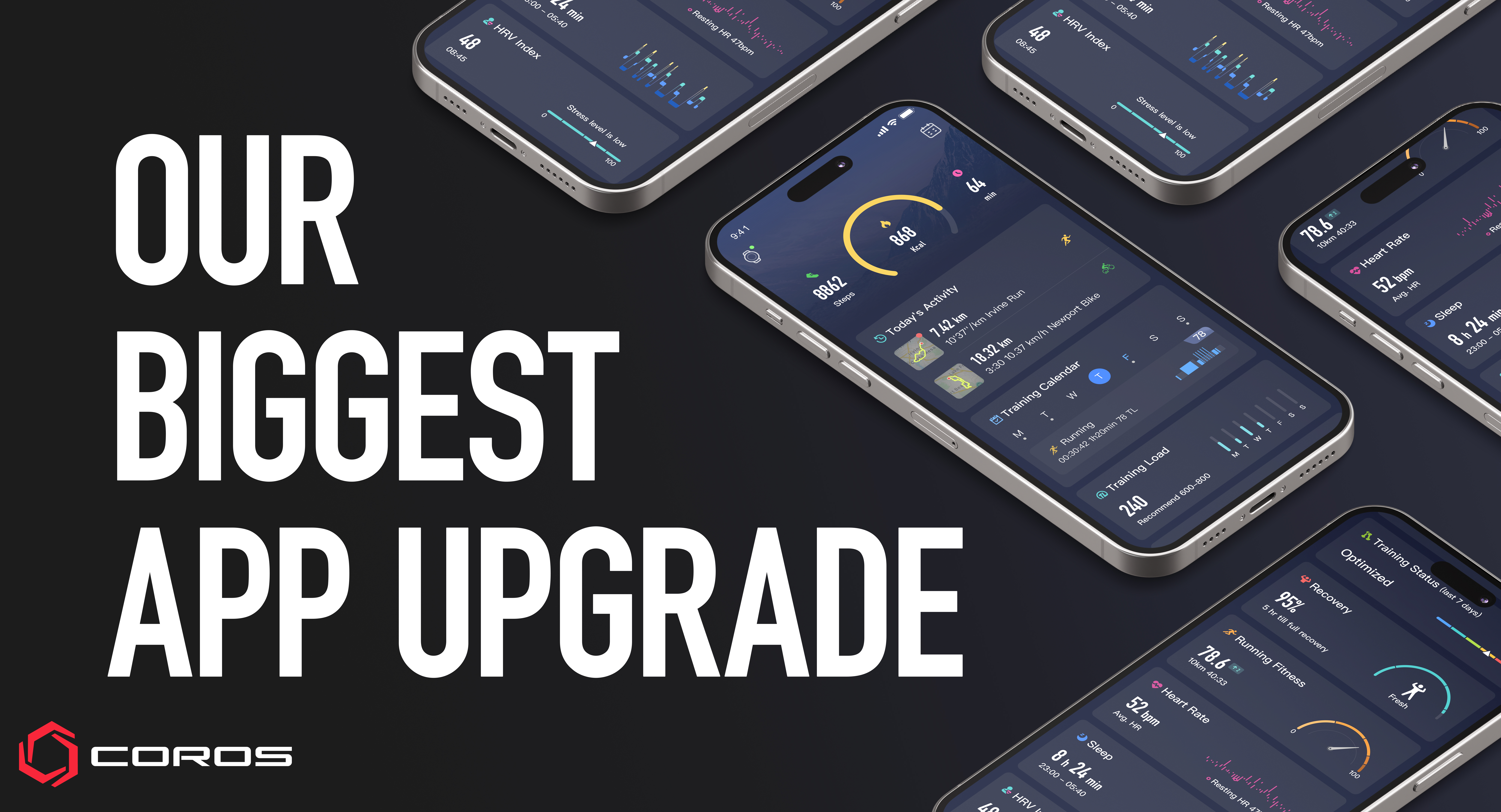
COROS Wearables Inc., makers of GPS sports wearables and training software, today announced the launch of its new mobile app, more accurate and detailed EvoLab stats, new watch firmware, and new API integrations with Google Health Connect, Intervals, and HRV4Training. The company also announced a price adjustment and credit offer of its APEX 2 models to offset the fluctuational change of the USD.
In its ‘biggest app upgrade to date’, COROS has redesigned its mobile companion app, which now features four simple pages, Progress, Activities, Explore, and Profile. As well as many standout features, there is a new Explore Page which includes an In-App Route Builder allowing users to draw, edit, erase, and download custom routes for runs, cycles, and more.
Episode 3 of Coros Convo brings two of the greatest mountain athletes of all time together for the very first time. Filmed in Tommy’s hometown of Estes Park, CO, and the day after Kilian’s record-smashing victory at Hardrock 100, they cover a lot of ground as they compare experiences and look to their futures.
What can they learn from each other? Where do they find inspiration? How do they achieve success, and will they ever collaborate?
Find the answers to these questions and more in this momentous COROS Convo!
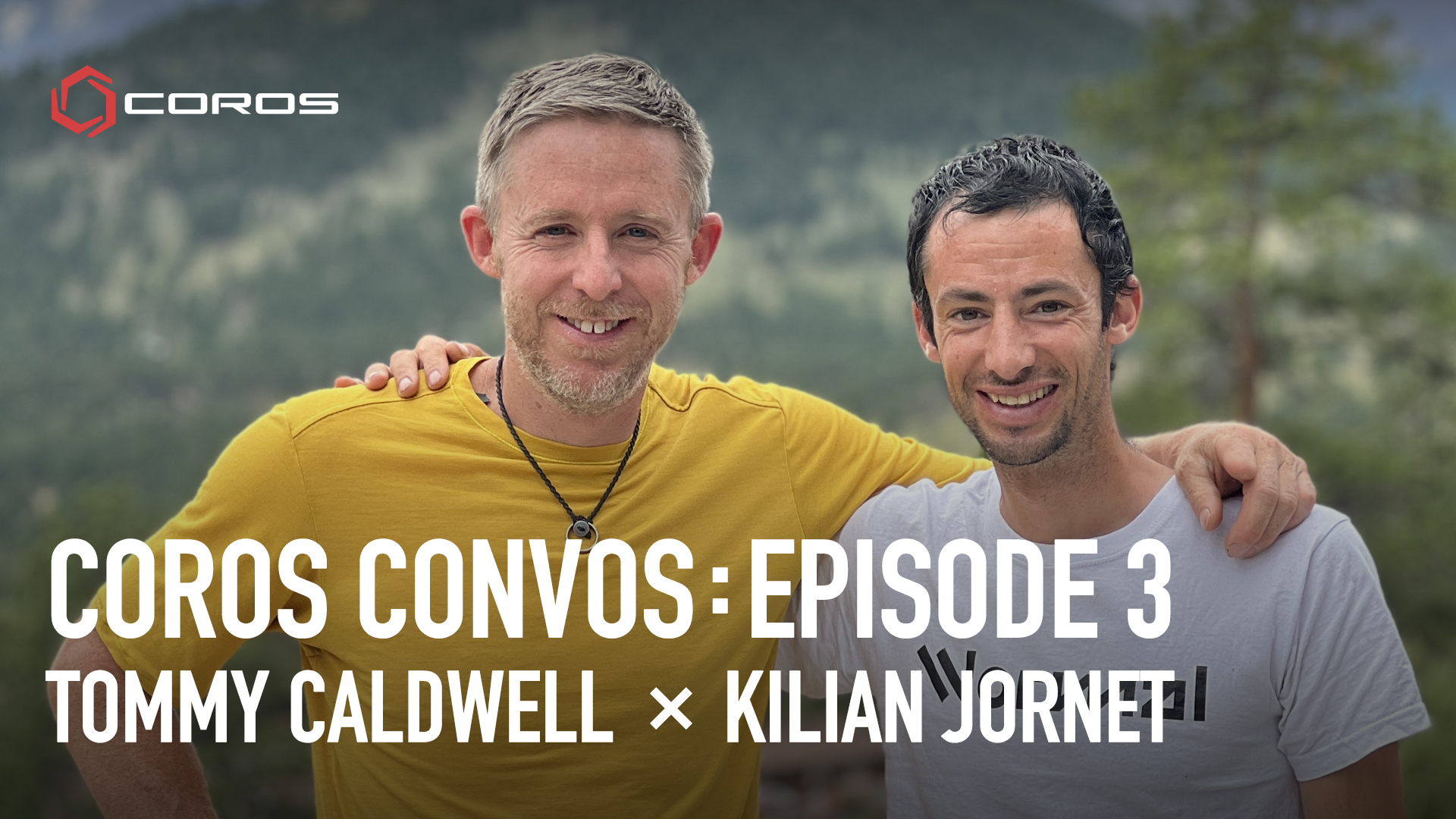
Kilian Jornet and Emelie Forsberg are the two newest athletes to make COROS their official GPS Watch
COROS Wearables Inc.,makers of innovative performance GPS watches is introducing Mountain Running and Ski Mountaineering World Champion Kilian Jornet and World Champion Mountain Runner Emelie Forsberg as its newest Pro Athlete Ambassadors.
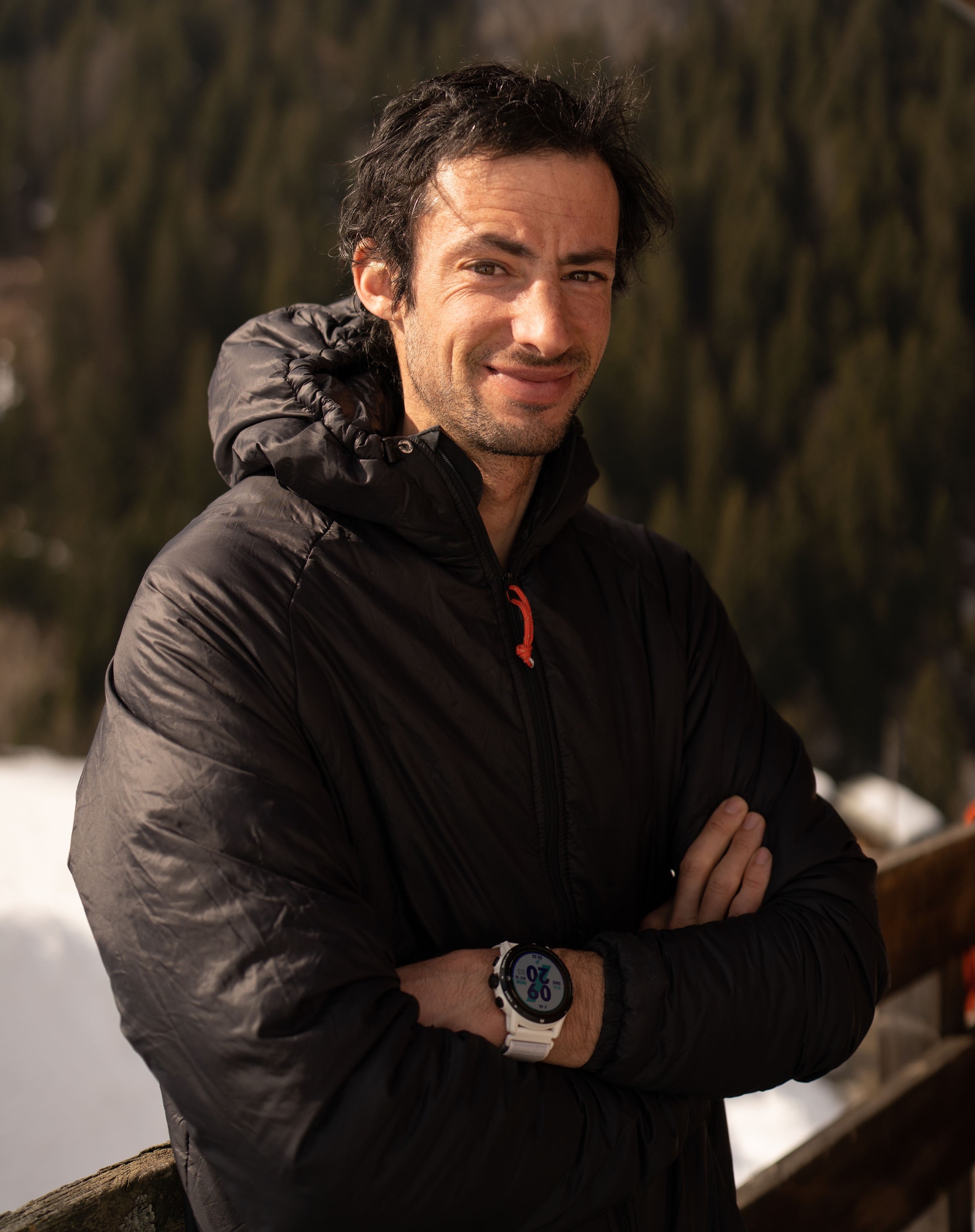
This partnership is yet another sign of the COROS brand’s commitment to performance training at the highest level. To forge the relationship and be able to experience the product in a performance setting, COROS Co-Founder Lewis Wu traveled to Norway to meet them both, and join Kilian for one lap of his local ski-mountaineering training loop.
Written by Euan Fitzpatrick
The below has been written as an account of a personal challenge – my first 50 miler. I had a great day and want to capture my thoughts before I forget them or let the retrospectoscope rose tint them too significantly. I learned a lot of lessons in training and the run up, and for 8+hours of the 11.5 hours of the run, it was very much Type-1 fun. I enjoy reading race reports – of which there are loads for the actual Highland Flings - and training blogs, and while this is really just for personal posterity, I thought I’d share in the hope that someone might get something from it.

I wake with a start at 01:17. It’s race day! I get ready, eat my customary 2 Weetabixs and 2 mouthfuls of coffee and get in the car. Kit had been set out the night before and these fast starts have now been well practiced. Usually it feels like it is early in the morning, but it feels instead like very late at night. It is 01:35... so I guess it is! I had managed a decent 3 hours of sleep and felt reasonably rested but not exactly brimming with energy nor confidence. It is race day though, and it starts at 02:00 so time to disengage the brain and just get it done. Keep the heed. Less thinking, more running! The car says it’s 19.5oC outside… 19.5 at 2 in the morning…uh oh.
Milngavie to Drymen
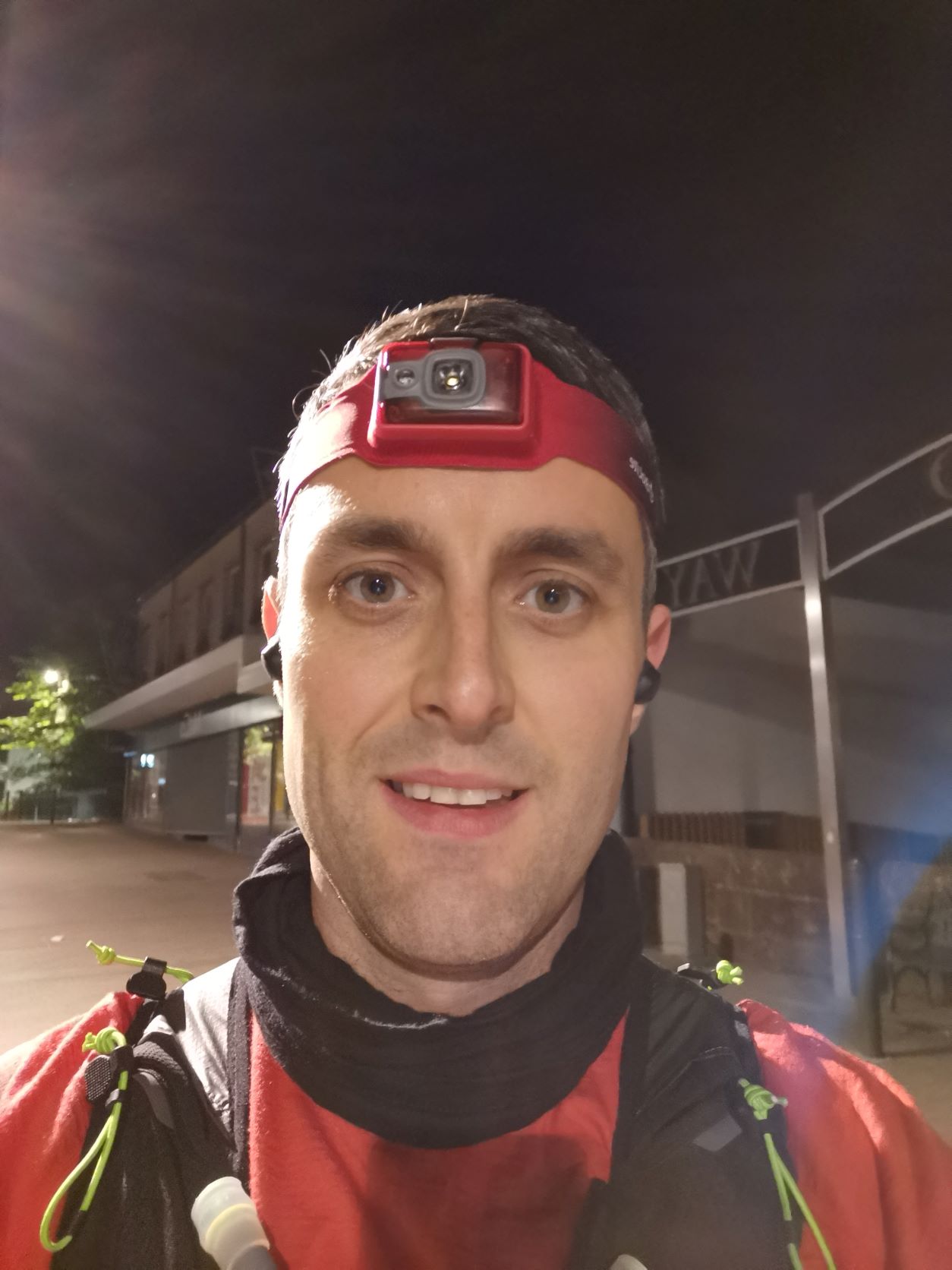
I take a selfie at the starting Obelisk, put my head torch on, start my watch and get going. I really like my new Biolite 200 headtorch. It is lightweight and bright and comfortable. It’s very simple to control and to adjust the strap for tightness. It’s perfect for this time of year – though the Silva is better for when the weather is a bit more Scottish. I start out listening to an audio book, but I can’t seem to settle so ditch it and this helps. The head torch casts fleeting shadows across the path and I get a fright a couple of times from bright eyes in the bushes, frogs on the path and a creepy seagull sleeping on the trail! Edgar Allan Poe’s Raven comes unbidden to mind - ‘and into that darkness peering, long I *ran* there wondering, fearing, Doubting…’.

This part of the route is an easy start – terrain is excellent for running and it is undulating with about 850ft ascent. In the West Highland Way guidebooks it gets a bit of bad press, but I think it is a lovely transition from suburbia into more rural Scotland. Already my HR isn’t quite where I’d like it to be. I reason to myself that it is warm, I am under-slept... but the doubts are there - is that all it is? Can I do this? I immediately walk the hills – “start slow and fade (as little as possible)”. My tactic for the day is to concentrate on the bit you are in – don’t remonstrate over what has gone before, or fear what is still to come – focus on now. At the big gate after the beech hedge, I lap my watch and see that this first section has taken me 2 hours as planned. Slamming the gate adds to the sense of completion. A good start to the day.
Clock: 02:00-04:01am.
Lap Target Time: 02:01 Actual Time: 02:01
Lap Distance: 12.21 Lap Pace: 9:54/mi
Total Distance 12.21. Elapsed time: 02:01
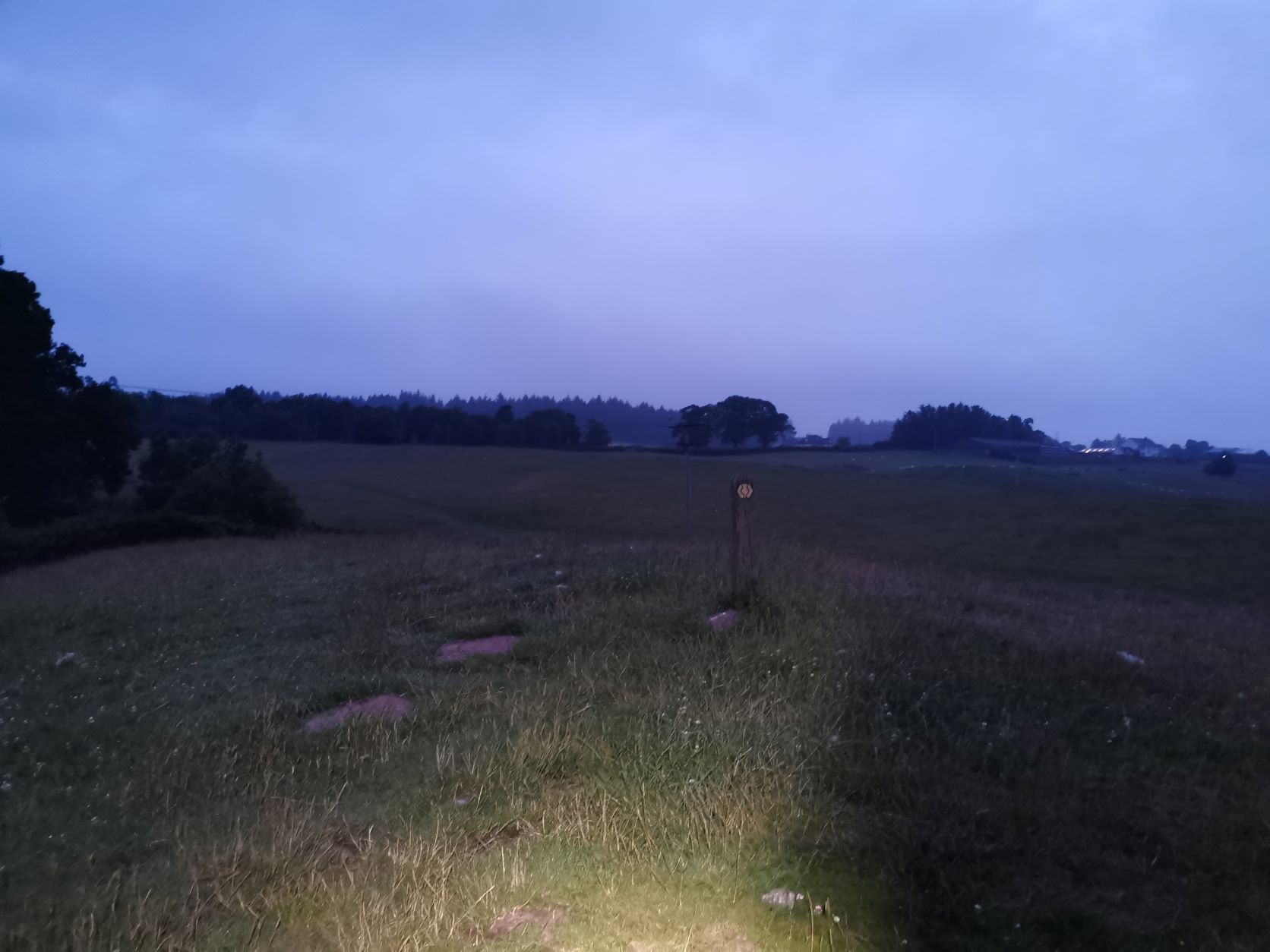
Drymen to Rowardennan
I approach this in two sections – Drymen - Balmaha and Balmaha - Rowardennan. I pocket the head torch early on and put it into the zipped rear section of my Inov8 Race Ultra Pro 5 pack. In a training run on this section, I dropped gloves and sunglasses and had to have a word with myself about taking care of kit – do not risk losing vital kit to save a few seconds. This pack makes storing things on the fly very easy. There was a low mist and while visibility was fine for running, the early views of loch Lomond were missing, and it wasn’t until the down section of Conic that I could see the Loch at all. I dropped into Balmaha slightly ahead of schedule and feeling good. I had walked the uphill of Conic and came down reasonably conservatively, conscious of saving my quads for the tougher sections to come. I was eating well – a gel every 4 miles and had drank around half of the 1 litre of tailwind I was carrying by this point. I had a drink from the new water tap at the Tom Weir statue, filling my collapsible cup – a simple but fantastic bit of kit that everyone should carry - which prevented messing about with the bladders. I lapped my watch just as I started the climb up to the viewpoint.
Clock Time: 04:01-05:22
Lap Target Time: 01:30 Actual Time: 01:20:46
Lap Distance: 6.93 Lap Pace: 11:38/mi
Total Distance 19.14. Elapsed time: 03:22
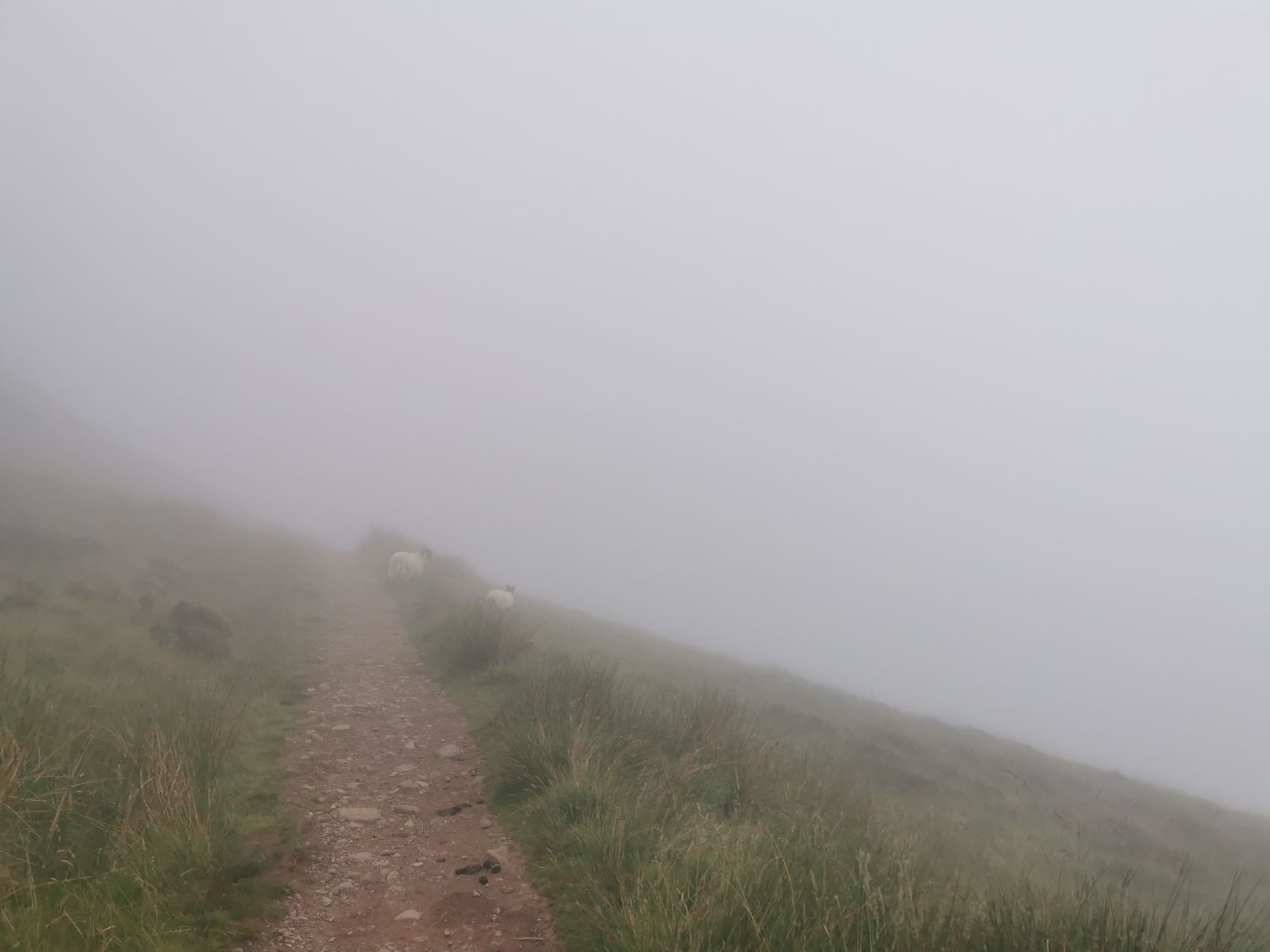
I find the next section quite tough because it is very runnable from a terrain perspective, but also hilly – and so it hits the legs and the lungs, and I think it would be easy to over tax both systems here. My heart rate was around 160bpm – previously when I’d run this bit I’d averaged 151 - so it was definitely elevated. On training runs this would perhaps have worried me but I was feeling good, running within myself, and knew that I had a long way to go! Heart rate training (MAF particularly) has served me very well, but on race day this needs to be treated as one of several bio markers - an indicator rather than a governor.
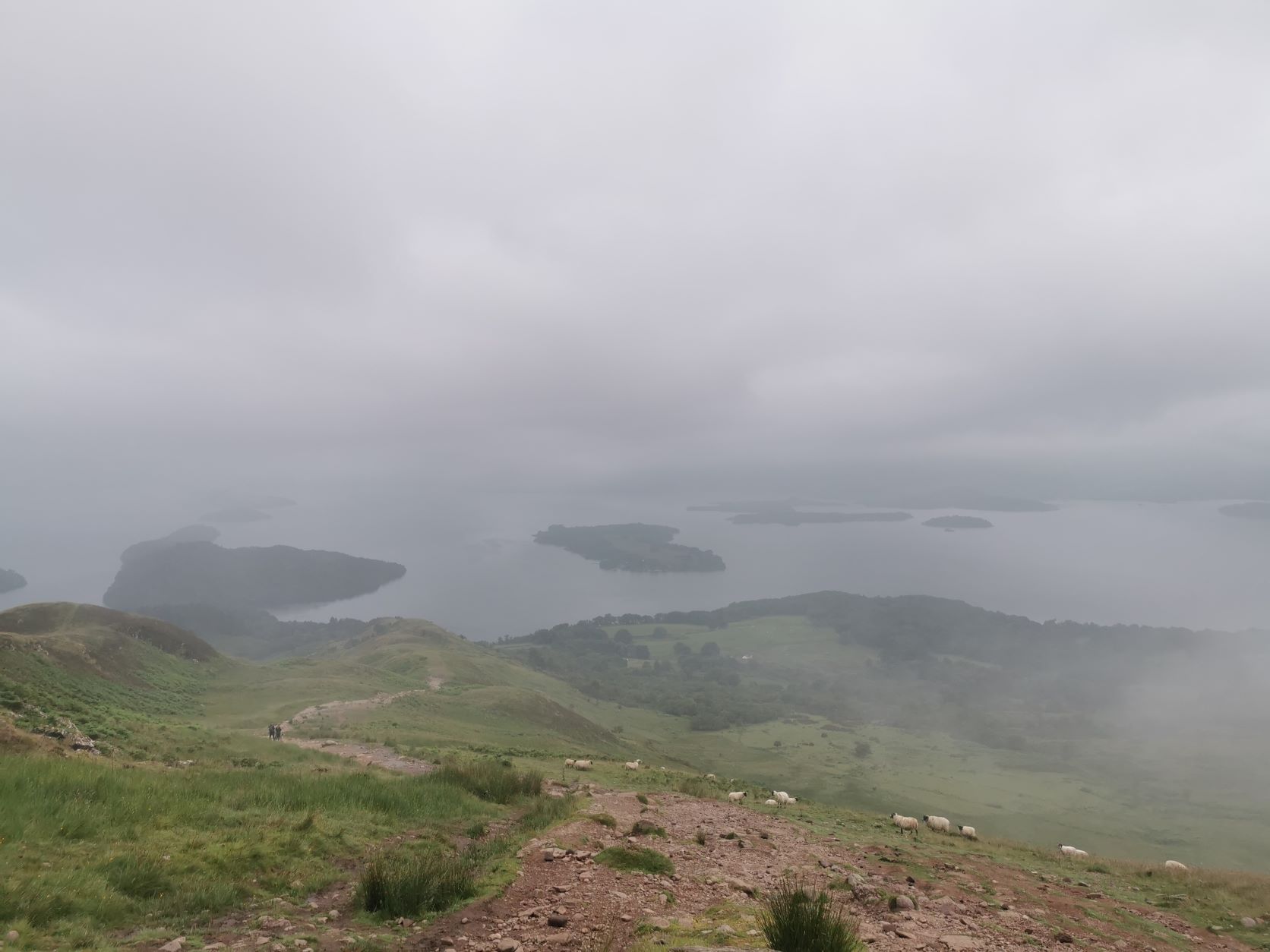
I reasonably enjoyed this bit but was glad that today it was a one-way pursuit and not the usual out-and-back. The temperature had cooled from the steaminess of Milngavie and the midges were only noticeable when I had to chew them. I had promised to text to my Wife and my Mum at Rowardennan and Beinglas, which I dutifully did - but I made a point not to read any messages or otherwise look at my phone – solo and unsupported.
Clock Time: 05:22-06:55
Lap Target Time: 01:35 Actual Time: 01:32:00
Lap Distance: 7.48 Lap Pace: 12:18/mi
Total Distance 26.62. Elapsed time: 04:54
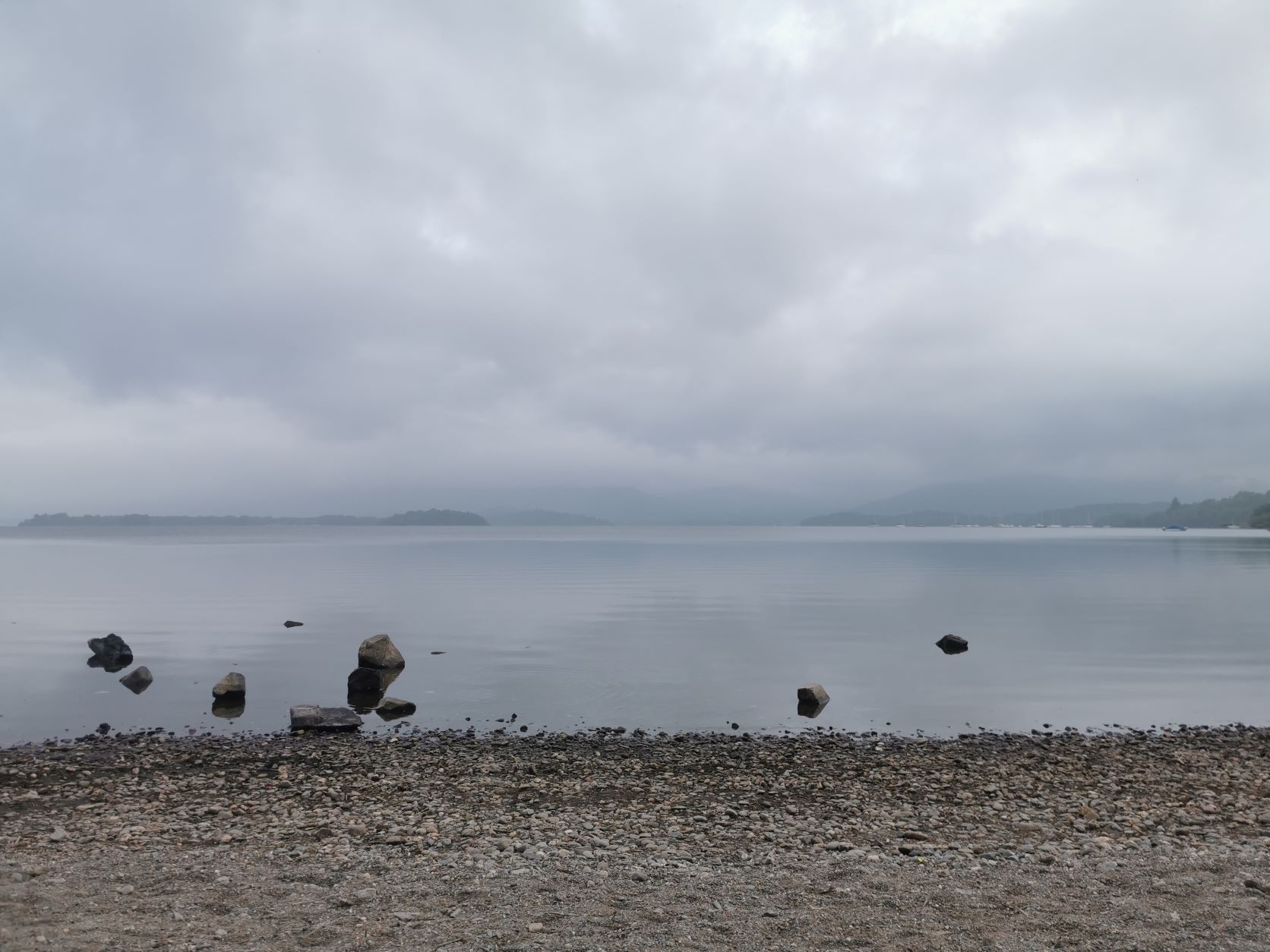
Rowardennan to Beinglas Farm
I was planning on re-filling my soft flasks at Rowardennan. I had been told there was a tap at the back of the toilet block... but I couldn’t find it and the actual toilets didn’t open until 09:00. An honesty box sorted me out with a can of full fat Irn Bru and I’m grateful that folk do this. For me there is a major psychological difference between running with some water/fluids and having none at all -and as the volume of liquid decreases, I feel an inversely proportionate urge to consume the remainder to zero. Fortunately, this is Scotland, and while the burns were running a little lighter than normal, I knew it wouldn’t be too long until I could top up my flasks.
These two sections (Rowardennan to Inversnaid Hotel, and Inversnaid Hotel to Beinglas Farm) are infamously difficult to run. I’d done a 27 mile out-and-back training run and had found them ‘not as bad as folk say.’ Indeed, when I was working out my target times, I thought I was being conservative. I guess there is a difference running these sections when you’ve already got 26+ miles, 3000ft of ascent and 5 hours running time in your legs. The rocks and tree roots were wet and very slippery. My Inov8 Trailflys are great shoes and I am confident in them, but I still managed to fall twice coming off awkward stones– hitting my lower back once and bashing my left ribs - and these incidents are a sharp reminder that a twisted ankle could finish the day early – and a twisted ankle when you are by yourself in the most remote part of the day’s route, could lead to a long, arduous and embarrassing extraction. I got completely soaked by the ferns that crowded the trail and it felt glorious as the coolness of the water was a comfort and a distraction. Poe’s Raven re-entered my psyche and reminded me I was losing a bit of time here – ‘and this is the easy bit of the tough bit!’ But I was able to silence the unsolicited doubts– I knew I was moving as well as I could and that it is better to be conservative and finish, than cocky and blow up. I was eating and drinking to plan, and the lower pace had let my HR drop a bit. I got to Inversnaid hotel and was able to fill up both softflasks. I put a sachet (2 scoops/2 hundred calories) of Tailwind into one of them, leaving the other as plain water. The individual Tailwind Sachets are excellent – they are pre-measured, the sachet tear open easily, yet are robust enough to survive being jostled in a stuff pocket – and the powder mixes rapidly with just a shake and no stickiness. The new Inov8 Soft flasks with the wide opening are very easy to use too and the more cylindrical shape go into the pockets easily - though they perhaps sit a little less flush with the body and so bounce a bit more. I fixed my pack on the move while some alfresco breakfasters look on with curious stares.
Clock Time: 06:55- 08:31
Lap Target Time: 01:30 Actual Time: 01:46:00
Lap Distance: 7.43 Lap Pace: 14:17/mi
Total Distance 34.05. Elapsed time: 06:40
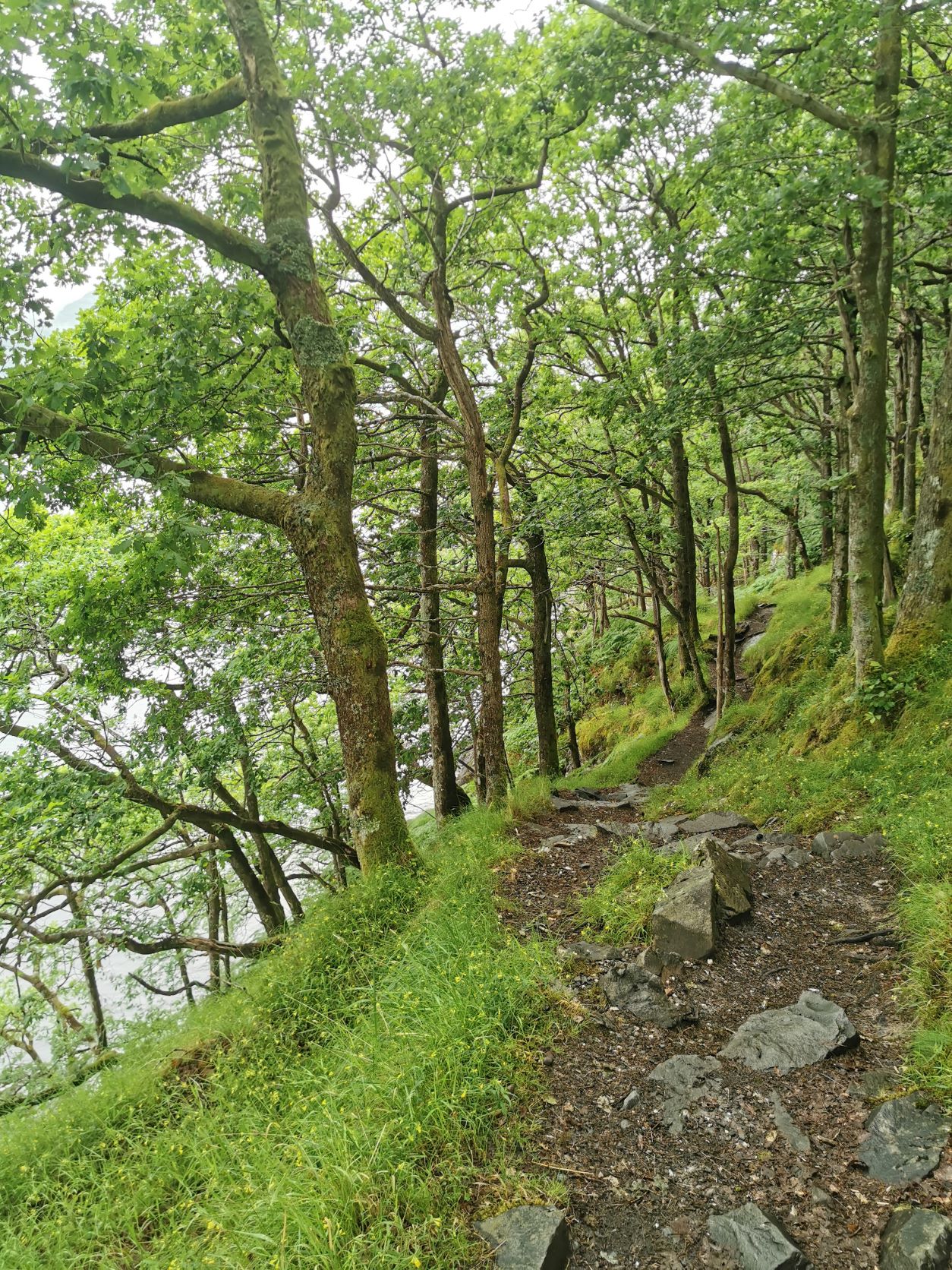
The first three miles after Inversnaid Hotel are the most stunted and technical of the day. Technical is maybe pushing it a bit but it is tough to run and the spectre of injury never left me. In this section you need to consider every foot placement and the short, sharp ups and downs drain the legs. Trail running is funny – the time/distance continuum is blurred. On the road at a conservative pace 7 miles is an hour. On the trail it could be 2+. It is very difficult to get any sort of rhythm or pace up here and this in itself is tiring. I will go back and practice this bit as I lost time here and I think there is perhaps some technique to be learned and honed. The trick will be to practice it pre-fatigued.
After the difficulty of the end of the Lochside, you are rewarded by a fantastic view South along the Loch and as you summit the hill there is a change of atmosphere and a distinct feeling of moving onto the highlands. Eventually, and it did feel like it took a while, Beinglas Farm Campsite came round.
At Beinglas I visited the wee shop and lost 3-4 minutes as there was no one serving. I had read that there is a tap somewhere, but I figured – perhaps incorrectly - that it might take me a while to find it and the shop would be quicker. On recce runs I will start to pay attention as to where I can get water and food and where emergency exits etc. I got a can of coke and a bottle of water, as I was expecting no further access to water until Tyndrum. I messaged my mum, as promised, and told her I was moving a bit slower than expected and to expect me in 3-3.5 hours.
Clock Time: 08:31- 10:25
Lap Target Time: 01:50 Actual Time: 01:55:19
Lap Distance: 6.75 Lap Pace: 17:05/mi
Total Distance 40.8. Elapsed time: 08:35
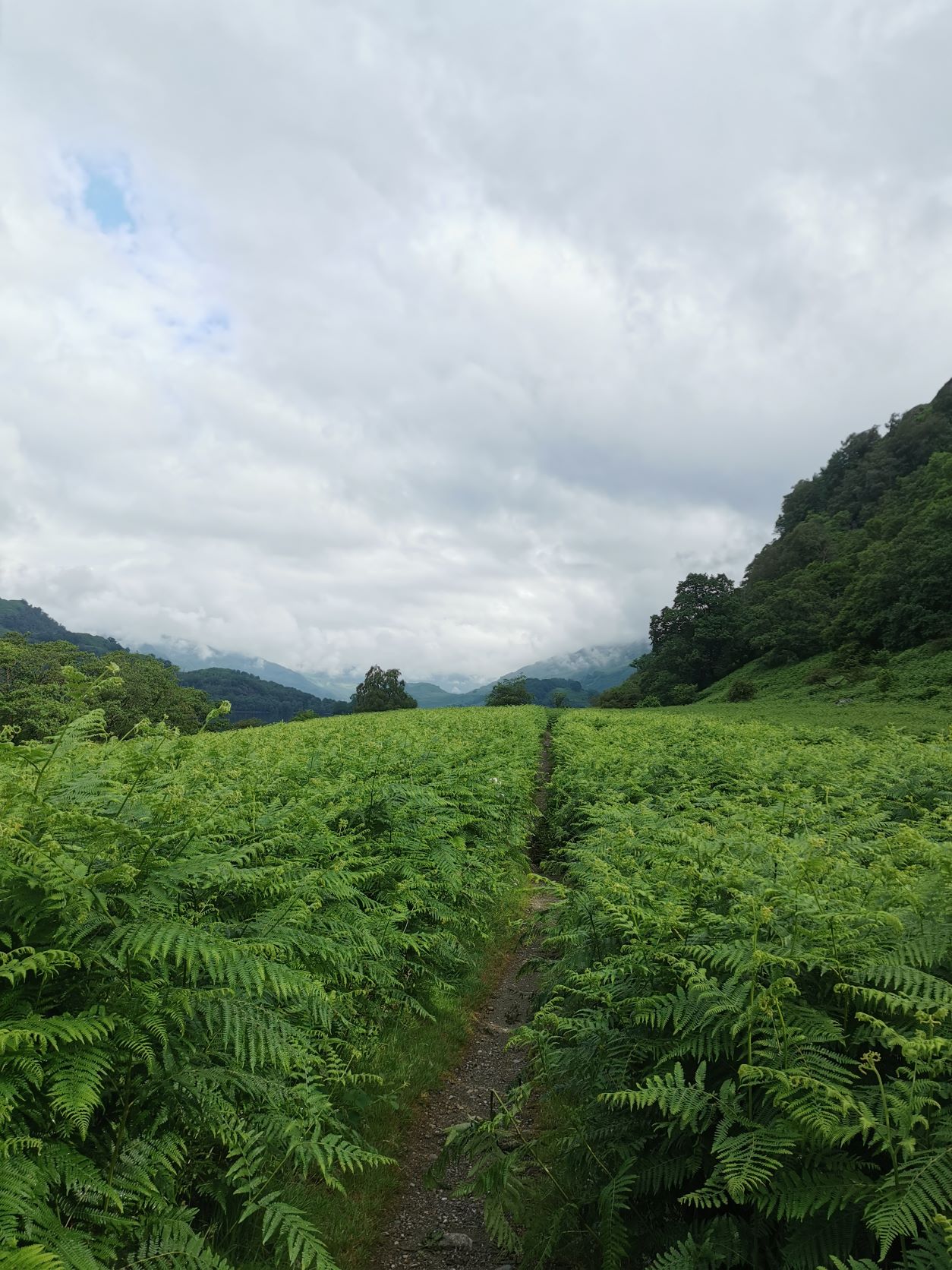
Beinglas Farm to Tyndrum
This was now the furthest I had ever run and into terra incognita both literally and figuratively. I knew the elevation profile suggested that it was basically a 7-mile climb – but surely it wasn’t really? The path is very runnable and a welcome relief that you don’t need to concentrate quite as much on foot placement. I used the initial climb to drink my can of coke and laughed at the fact that in training everything is precise – a gel at this point, a drink of water here... while in the event I’m running along drinking a can of full fat coke and burping away. There is a bridge missing and I could have climbed down and back up but instead opted for taking the high road where I assumed there would be another bridge. This part of the route is very easy to navigate though by now the sun is high and I’m sweltering. I’m at the mouth of the pain cave... and the raven is nudging me in.
The uphills keep coming. The flats don’t feel particularly flat and the down hills are sorely missing. I have a couple of strategies when it gets like this. On my left hand I count to ten on each finger, using my thumb as a marker. I go from pinkie to thumb and back – so 100 count. Both hands is 200 hundred and I then walk or run or just start counting again. It acts as a distraction. The other tactic is to pick a spot in the distance and run to it.
I recognised a couple of waypoints– Derrydaroch farm, the crossing of the A82 and I could see what I assumed is Ewich forest up ahead. I walked/hiked a lot and the lack of knowledge of what was to come perhaps led me to be overly cautious. It isn’t fun walking, when you should be running – and it leads me to feel like a bit of an imposter. Now that I can retrospect, I realise that even though I was walking, I was moving much faster than anyone else on the trail. I was passing other walkers and indeed no one passed me the whole day going South to North. I crossed paths with the one and only other runner I saw that day. He was running faster and better downhill towards me, looking strong and fit and lean and overall that he had his shit more together than I did and again the Raven whispered a wee message of discouragement and despair.
It was also around here that I realised that it hurt to walk, and it hurt to run - and this is a run, so run! This sounds daft to write, but it was a revelation at the time. There was no real feeling of injury, just soreness and soreness is to be expected. In fact, if I wasn’t sore then I wasn’t running hard enough, and I’d be morally forced to keep on going right through Tyndrum! This too shall pass. I was actually aiming for puddles as they cooled my sore feet. Eventually I reached a gate and the path diverged right to Crianlarich and left (and uphill…) to Tyndrum. I guess this is the end of this section then!
Clock Time: 10:25-11:53
Lap Target Time: 01:15 Actual Time: 01:28
Lap Distance: 6.10 Lap Pace: 14:24/mi
Total Distance 46.9. Total time: 10:03
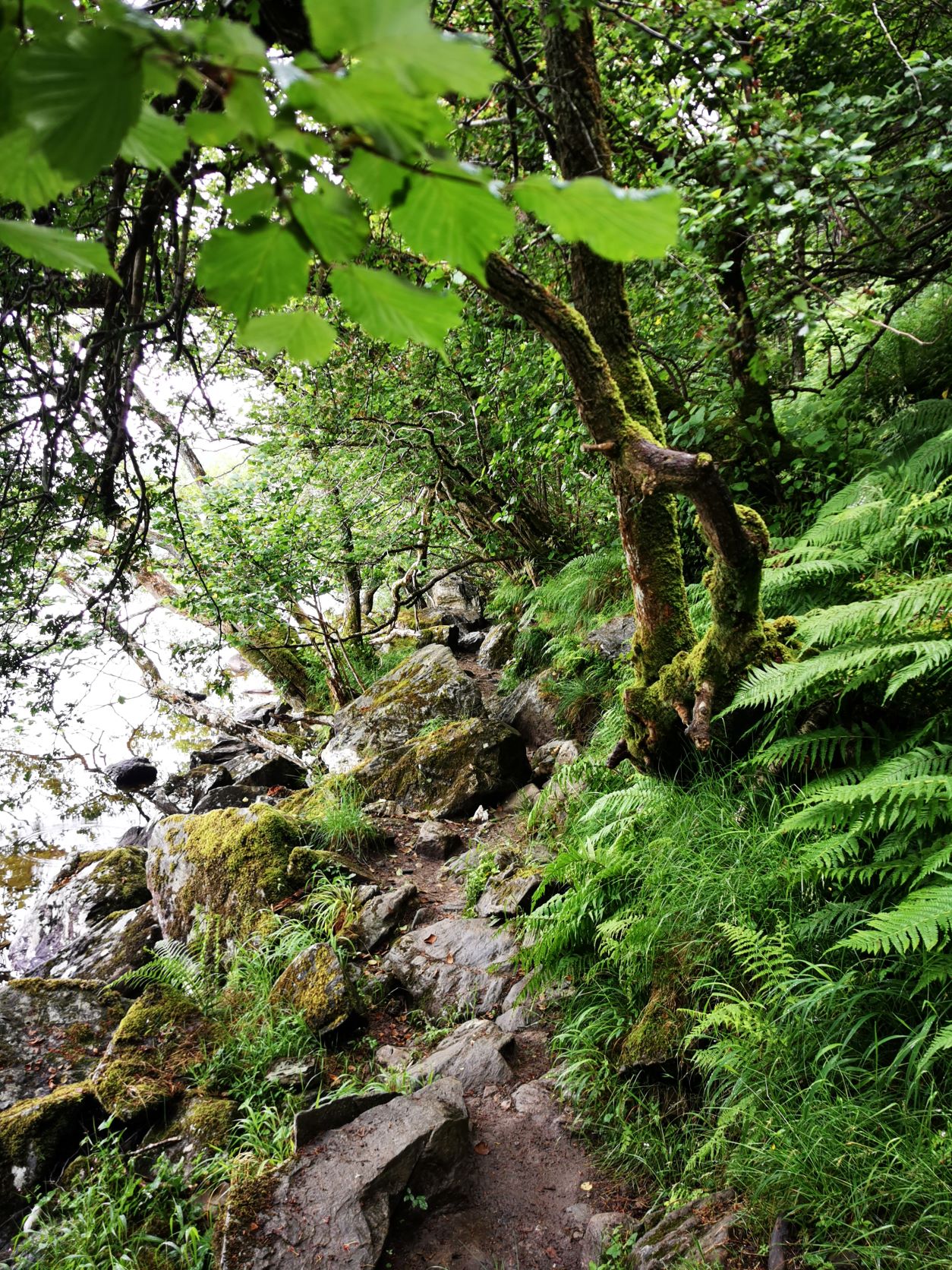
I bet it is great fun to run this bit when you are fit and up for it and not 47ish miles into your day. Or perhaps 47ish miles in and fitter and more up for it than I was by now. It is often referred to as a rollercoaster. The ups felt never ending and the downs sharp and leg sapping. It was the first time I’ve ever really experienced quad cramping and while it never stopped me, it slowed me somewhat. I was passing folk on the trail here and there and this gave me a minor lift. They were hiking but it was good to see some people and exchange a few words, even if very fleetingly.
Crossing the A82 took two or three minutes. It was mobbed. If I was fresher then I would have treated the road with my usual Glaswegian disregard for traffic– but physically and cognitively compromised as I was, I waited until the road was very clear. After a few minutes of shuffling along the next bit I realised that it was a very good runnable road – and that if I concentrated on a proper running gait and lengthened my stride it would be possible to get some life and pace back into me. I started to walk for 0.1 miles and then run for 0.1 miles, and quickly changed to 0.05/0.20 which ticked off a quarter mile. I didn’t really know where I was, but the route is well signposted. A sign told me 1.5 miles to Tyndrum, so 6 of these walk-runs… and then 5, 4… Then there was a sign for ‘By the Way Campsite 500m’ and for some reason that rang a quiet bell in my jaded mind. “Wait a minute – that’s the finish!” It was easy to find another 500m of pace which I must have kept in reserve. I guess not knowing the last section at all means that you don’t know when you can afford to push and ultimately, I finished with a bit left in the tank. At By the Way Campsite my Garmin read 52.88 miles, so I ran up Station Road until the watch said 53.00m and stopped. There is always a nervous second when some internal monologue tells you ‘Just press save…DO NOT DISCARD THIS ACTIVITY’. And then it’s saved. And it is done. And you can stop. And there is a wee bubble of emotion and you wonder if you are going to tear up. Done. 11 hours 28 mins.
Clock Time: 11:53-13:28
Lap Target Time: 01:25 Actual Time: 01:25
Lap Distance: 6.07 Lap Pace: 13:58/mi
Total Distance 53.00 Elapsed time: 11:28
Totals:
Clock Time: 02:00-13:28
Elapsed time 11:28
Distance 53.00 miles Average Pace 12:59m/mile
Ascent/ Descent 7263/6548 ft
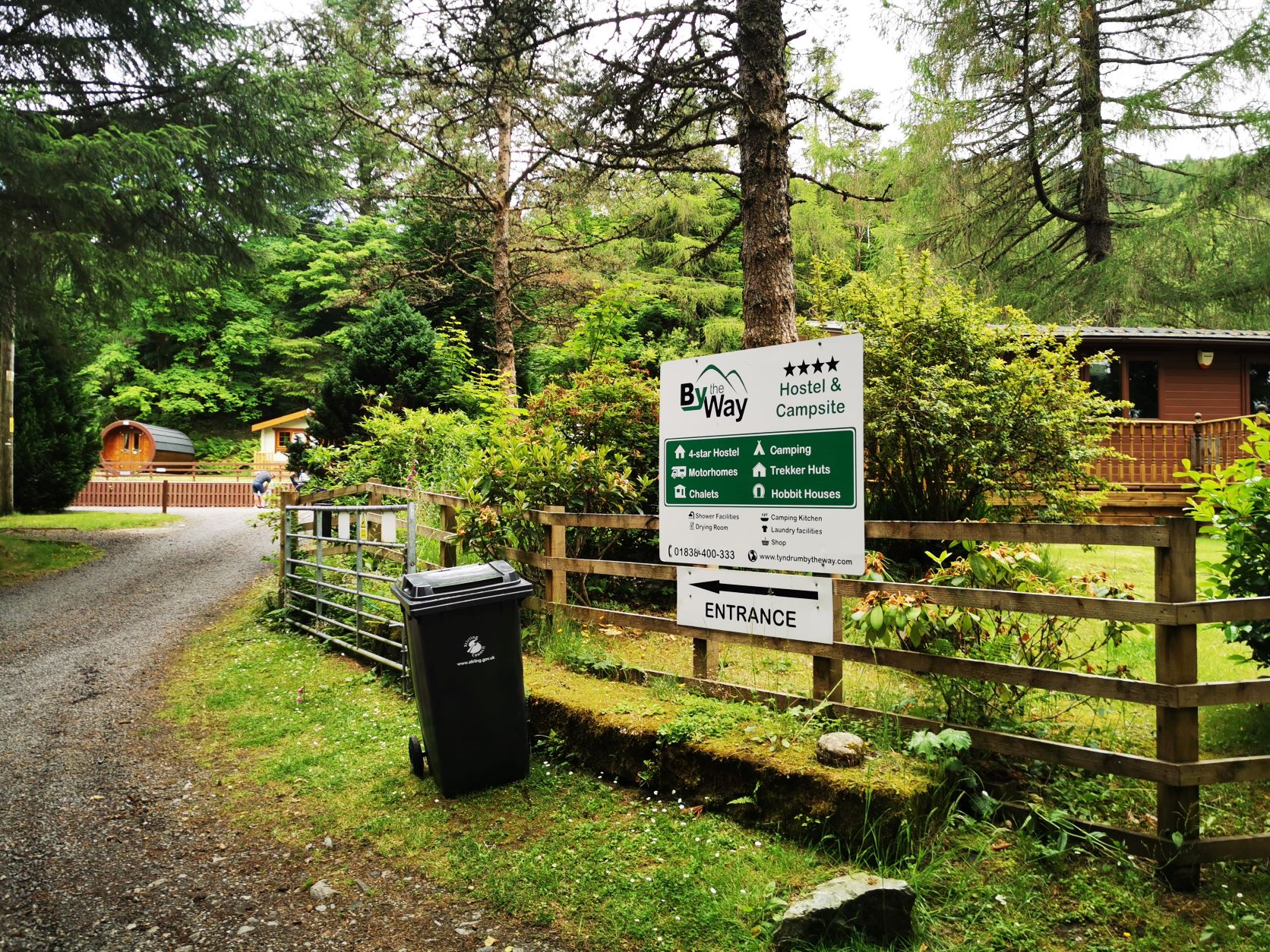
After
I walked up towards the Green Welly Stop where my mum was collecting me. I felt pretty good all things considering. I was doing a wee scan of the body and there seemed to be no pain, just soreness. There was no sudden drop in blood pressure or cramping and I was walking well.
I sat and had an ice lolly and a chocolate milkshake, enjoyed the sun and contemplated ‘how on earth do folk do the full thing!?’ My mum picked me up and we headed back to Milngavie. I enjoyed the drive down the road. It’s a beautiful drive that runs alongside the route for most of the journey – and it’s a funny feeling that after 50 mins travelling fast in a car, you can still point out highlights. Physically I felt decent, and undoubtedly better than expected. A couple of minor blisters and chaff. The strangest thing was my voice felt very weak and my mouth felt a bit cut up and grazed – and it was uncomfortable to swallow food. I’ve wracked my brain about this and reckon it could only be due to heavy breathing for so long as I hadn’t eaten anything that would do this damage. My Garmin ‘Body Battery’ flat-lined at 5 immediately post-run, and after 9 hours sleep on Saturday night had recovered only to 12! Usually I would expect 7-8% per hour. I was moving fine on Sunday but generally feeling a bit ill and headachy. Stairs were do-able but not desirable. I was expecting second day DOMS to be worse, but by Monday I was moving easily and could’ve gone out for run. I’m going to give myself the week off because even though muscles, etc, feel fine, I do feel a bit under the weather and my mouth is still sore and I feel that it probably won’t help me recover any more than an extra hour in bed would.
Retrospecting
It’s been great to build up towards something. With baby number 3 due in a couple of weeks there is a high probability that training is going to get very disrupted, so being able to tick off an achievement before my fitness wanes has been great.
Training – I feel that I’ve been de-training to an extent and I know that the training stimulus needs to change. MAF served me well but my self-planned training schedule of progressively longer and longer Long Runs was diminishing in returns and starting to affect overall health and training consistency. Still, it serves me well enough – but time to get a bit more scientific about it. There is no mystery these days on how to train most effectively and productively. I need to get used to running a bit sore. I also want to see how well I recover from a 20/10 back to back vs a 30 miler.
Vo2 max/tempo stuff – I am going to try and introduce a weekly hills or speed session. I’d like to build a gearbox and I think my next goal will be a road Marathon PB. Truth is I’m not that bothered about road running, nor really marathon PBing but it is much more accessible and for the next 12-16 weeks and I need to minimise excuses not to train consistently. I also feel the need to push for a bit of pace.
Other thoughts or points for posterity-
- Gear: My trusted and ancient Inov8 merino wool t-shirt. This thing is incredible – sweat wicking and odour free. Inov8 Race Elite 6-inch shorts. Inov8 Trailfly ultras. It would seem I’m a fan boy and perhaps I am, but it works for me. Nothing new on raceday. Inov8 Race Ultra Pro 5 hydration pack, with 2 x 500ml soft flasks. I wear the flasks in the lower pockets and use with tubes – will experiment with top pockets instead and see how I get on with them up there. Inov8 speed cup. Biolite 200 head torch. I also carried my Inov8 race waterproof jacket; merino buff; space blanket; tick remover; gloves; map.
- Fuelling – I started out with 12 gels and a plan to eat one every four miles.. I’d batched these in 4 x triples, meaning one batch per section. In the triples I had a caffeinated High5, a High5 Aqua (which I look forward to) and a Cliff shot. The variation is meant to make them more palatable. I finished with 3 leftover however, which meant I must have skipped some. This isn’t great. If the plan is to eat every 4 miles then I need to be disciplined and do so. I didn’t consciously not eat them but rather forgot or missed them. On the day – breakfast of 2 weetabix, 9 gels, can of Irn bru, can of Coca-Cola, half a dozen mint imperials, 3 loads of Tailwind (200 calories each). All in probably around 2000kcals. No carb-loading the previous day – just ate normally. I must be reasonably adapted now – and I think I’ve trained my gut pretty well as not a single GI issue. Could I have continued with this strategy for further distance? I think I could from a GI perspective, though perhaps mentally something else would be better. I should experiment with real/solid food and see how I get on with it too. Hydration – I didn’t keep track of this, but I reckon I imbibed around 3-3.5 litres – on paper this might not be enough… but it felt fine on the day.
- Watch settings. On my Garmin Fenix I turned off autolap and used the lap function to accurately measure my lap time. I had target times for each section. Starting at 02:00 also made it easy to compare where I was without having to worry about messing about with my watch. The watch never beeped at me to remind me how far I was in (or how far I still had to go), or how high my heart rate was. This meant I never noted ‘new furthest distance’ or ‘that’s me at 50 miles’ and I never worried... 30 miles to go! I felt this worked well.
- Running on 3 hours sleep cause that’s all you can get because you’ve got time to run, or you’ve got time to sleep but you don’t have time for both. Starting at 02:00 because by your absence are already leaning heavily on your wife – leaving her all day with two children under three, and her heavily pregnant- while you go and knacker yourself in a misguided bid for some sort of self-actualisation!
- 11.5 hours on your feet. No sit downs. 101,000 steps in a day.
- My Watch says it was 27degrees at the toughest bits. Running this in April would be easier for sure.
- In the week before, I had been getting progressively more nervous about it. I had clearly been gung-ho about the whole solo and unsupported thing. This is how I train but more out of necessity than design. I consider myself a sociable person, but its just that other folk don’t want to run at 04:30 on a Saturday morning. Truth is, I don’t really want to run at 04:30 on a Saturday morning… but at my point in life I’ve got time to train or time to lie in and not both. If someone had offered to run the last section with me, I’d have taken it and would have benefitted from it from a pacing perspective, probably. There were folk I could have asked, but I left it late and it was only my fear of the event that was making me doubt my ability.
- Unsupported means unsupported. No looking at messages, no phone calls, no twitter feeds, or Facebook… no external help. Fuck all. Solo and unsupported. If you can find it on the trail you can use it. If you can’t get it, you can’t have it.
- Having said all that in points 7 and 8 - there is something pure about carrying your gear and not relying on aid stations and drop bags and doing it by yourself. It is good to know that you’ve got it in you and that you don’t need the support and comfort of other people to get you through. It is a test of self-reliance in a world where there is a focus on comfort and ease – for it to be an endurance event, you need to endure! If this was easy, we simply wouldn’t do it!

Ultramarathons aren’t for beginners – training to go an ultra’s distance of at least 26.2 miles will take some serious commitment. A Healthline article details how it can take up to six months to prepare for these marathons. This is why it might surprise you to know that some celebrities, despite their busy schedules, have taken this challenge on successfully. Here are some of them:
Sophie Raworth
Video:
Sophie Raworth is the main presenter of the BBC News at Six and the deputy presenter of the BBC News at Ten. Despite her fast-paced work in the field of journalism and broadcasting, she continues to be an impressive marathon runner.
Raworth has completed all six World Marathon Majors, and has run fifteen other marathons as well. She has also finished three ultramarathons, including the Marathon des Sables. This is a 150-mile ultra in the Sahara desert and is known as the hardest foot race on Earth. Raworth wrote about her experience on the BBC, describing it as ‘the toughest – at times hellish – but most wonderful, rewarding experience’ she ever had. After all, this specific ultra requires runners to carry enough food and water for the week, as well as other supplies such as a sleeping bag, compass, venom pump, and whistle.
Gordon Ramsay
Video:
Gordon Ramsay is a popular celebrity chef and restaurateur. He ranks high among Michelin star chefs, currently holding seven stars across four restaurants. He’s also well-known for his fiery personality on TV, as well as now being a travel presenter. Foxy Bingo details how he is part of Gordon, Gino & Fred: American Road Trip, a food and travel show where the three hosts, especially Ramsay, show off their competitive sides. The site highlights this by reporting on Ramsay’s annoyance that his fellow host one a competition.
Outside of entertainment and food, the celebrity chef has put this competitive nature to good use. Ramsay became a runner and triathlete in order to keep his health in check. He did his first marathon in 2001, and he struggled to finish. But with hard work and time, he has since greatly improved. In fact, he has run the Comrades Ultramarathon in South Africa, even considering it as his best run as he was able to also see amazing parts of the country.
Jonny Lee Miller
Video:
Jonny Lee Miller achieved early success as Simon ‘Sickboy’ Williamson in Trainspotting. He received a London Film Critics’ Circle nomination for Actor of the Year for his role as Graeme Obree in The Flying Scotsman. He received Satellite Award nominations for Best Actor for his roles in the BBC costume drama, Emma, and in the CBS crime drama, Elementary.
He has also run several marathons, including an ultra on behalf of Jonah’s Just Begun. This is a non-profit organisation that raises money and awareness for Sanfilippo – a disease affecting an estimated 1 in 250,000 people worldwide.
Ultramarathons can seem overwhelming. However, with enough preparation and a bit of dedication, you’ll surely be able to achieve what these celebrities have. James Young provides some tips for running your first ultra.
Press release from Salomon
Brand pledges to offset the travel carbon footprint of its international athletes by 2022 and reduce its athlete-related travel carbon footprint by 30% by 2025
ANNECY, FRANCE—Salomon, the outdoor sports brand headquartered in the French Alps since 1947, today announced new sustainability goals centered around its sports marketing efforts. Long known for its collaborations with mountain athletes and its connection to local sports communities, the company is committing to improve the carbon footprint of its in-person events and reduce the environmental impact of its athletes and ambassadors. Many of the actions included in this new sustainable sports marketing charter have already been implemented and the company has formed a list of related sustainability goals to meet by 2025.
This two-pronged approach around events and athletes will begin with sustainability studies of existing in-person events, which will allow organizers to set specific goals around gatherings such as Golden Trail Series races, the Salomon freeski team’s annual Mountain Collective, and community events like the Salomon Mountain Academy on Snow. In addition to these “owned” brand events, Salomon will also onboard the hundreds of Salomon-supported community events worldwide on this journey to a more sustainable sports marketing program. “One of Salomon’s strengths is its genuine connection to a loyal base of outdoor enthusiasts who practice our sports and share our love for nature,” said Bruno Laroque, Salomon’s Manager of Global Sports and Community Marketing. “That’s why, in addition to our ‘owned’ gatherings, we are taking measures to support the local communities who stage Salomon-sponsored events around the globe. The event parameters we set will influence what we commit to as community event organizers and what we support as event sponsors.”
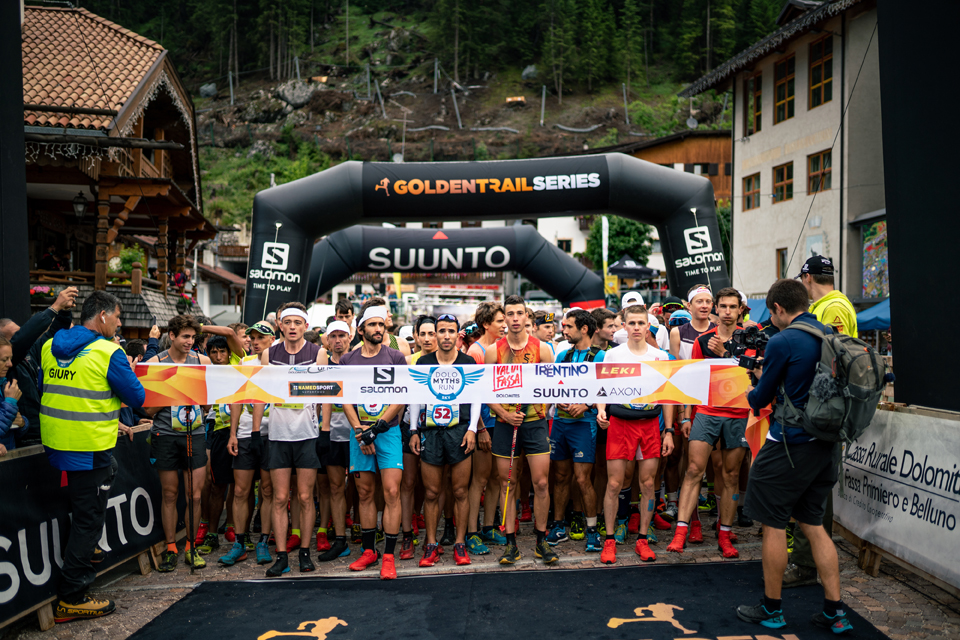
Salomon is also committing to reduce the collective carbon footprint of its international athlete team by 30 percent by 2025. Beginning in 2022, the company will also offset the global carbon footprint of its international athlete team. Currently, the sports marketing and sustainability teams at Salomon are measuring the individual carbon footprint of each international athlete and will work with each of them to lessen their impact. Part of that effort will involve Salomon athletes agreeing to participate in more local events to reduce their travel and sign a contract that allows the company to measure their individual carbon footprint and reduce it wherever possible. Additionally, athletes will be asked to adjust the amount of equipment they use to their minimum needs and
repair that gear whenever possible. “Salomon athletes have always pushed their sports in new directions and, when it comes to sustainability, many of them have been instrumental to the overall commitments the brand has made in recent years,” said Laroque. “They have reduced their personal carbon footprints by altering their means of transportation and even dedicated their time to educating the next generation on climate issues. It makes perfect sense for us to partner with them so that we are all being more mindful of the environment in the work we do together.”
EMELIE FORSBERG TO ASSIST WITH NEW SUSTAINABLE SPORTS MARKETING CHARTER
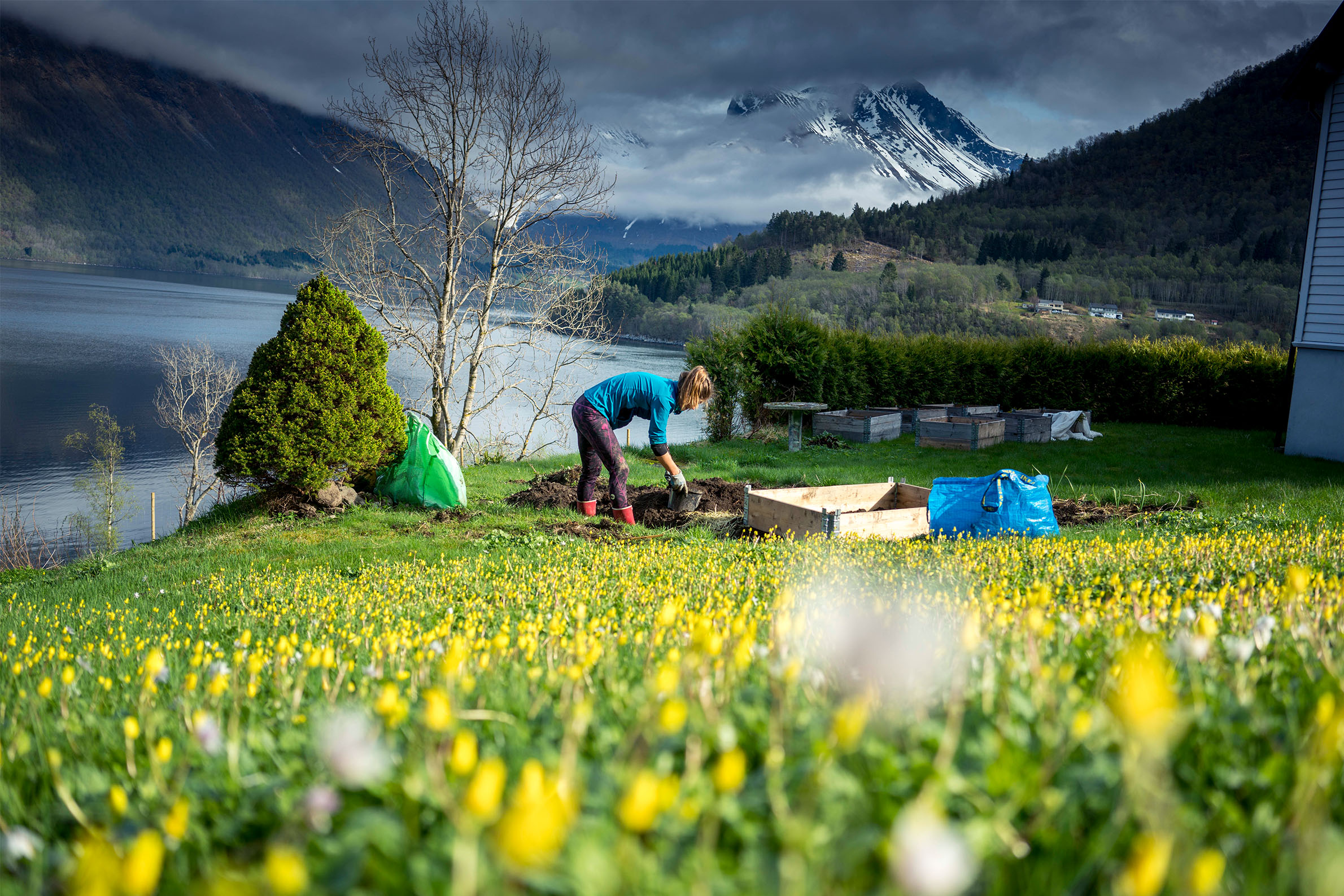
Using her years of experience as a Salomon trail running athlete and mountain adventurer, Emelie Forsberg will play a lead role in helping the brand build this sports marketing charter. She will liaise with the international athlete team and connect with the outdoor community as an advocate for the program, which shares many of her values. “Salomon has been working on its Play-Minded sustainability program for a couple of years now and I have been part of it from an athlete point of view,” said Forsberg, who organized the Tromsø Skyrace beginning in 2014 with an emphasis on minimizing the environmental impact. “In recent years, I’ve seen a number of athletes planning their travel schedules to reduce their impact, which is their way of making a difference. We know that big changes must come from above, but when we start asking what we can do to reduce our impact, that grassroots-level thinking inspires big changes from higher up, so I’m looking forward to evolving my role with Salomon in this area.”
Together with her partner, Salomon mountain athlete Kilian Jornet, Forsberg has dedicated more time to this cause in recent years. The couple live on a small farm in Norway, growing their own vegetables and advocating for sustainable sports practices. In fact, the Kilian Jornet Foundation’s “Friendly Outdoor Pledge”—which calls on athletes, organizers, equipment manufacturers and federations to commit to making outdoor sports more sustainable—helped shape Salomon’s efforts around more sustainable sports marketing initiatives.
“We are committed to promoting sustainable sport development through protecting our playground, as well as supporting our athletes and players towards a responsible sports practice and lifestyle,” said Marie-Laure Piednoir, Salomon’s Sustainability Program Manager. “We are convinced that, beyond working towards limiting our impact in our own operations and activities, we have an even stronger responsibility and can have an even stronger impact towards changing practices by promoting this sports marketing charter. Perhaps the most encouraging aspect of these efforts is that we have the full support of our athletes, who are already showing us
the way in many of these areas.”
COMMUNITY EVENT COMMITMENTS
In addition to choosing partners that share these environmental values, Salomon intends to realize the following event-related sustainability goals by 2025 and to support the events it sponsors in achieving them:
· Water protection by avoiding overconsumption and pollution
· Clean energy sourcing by switching, wherever possible, to renewable energy
· Responsible sourcing through re-usable and sustainable event materials (such as marking flags and banners)
· Creating responsible race packs by sourcing eco-friendly, local, fair and offering the opportunity to refuse the pack in lieu of a donation to an environmental cause paid by Salomon
· Waste management through re-use, recycling and reduction
· Banning plastics such as bags, trophies, gifts, bottles and glasses
· Responsible catering through the sourcing of local, seasonal and organic food with a vegan option
· Optimizing event transportation by offering low-carbon transportation and promoting soft mobility
· Communicating responsibly by banning helicopters for filming and the promotion of events
· Offsetting event carbon emissions and offering a travel carbon-offset option for participants during their ticket purchase
· Protecting natural habitats through environmental assessment, preservation work and controlling the impact of participants through crowd-size moderation (using start waves at races and through environmental protection education during races)
· Identifying a sustainability manager for each event and briefing volunteers on the event’s sustainability
· Promoting diversity and inclusion by supporting equal treatment and balanced split of women and men in races, by training race directors on diversity and inclusion, and by promoting diversity and inclusion among race staff and promoting the accessibility of events
· Engaging in dialogue with international federations and series organizers to optimize race calendars
ATHLETE-RELATED COMMITMENTS
Also by 2025, Salomon is committed to achieving the following actions related to its international athlete team:
· Measuring the individual travel carbon footprint of each international athlete
· Reducing by 30% the collective travel carbon footprint of its international athletes by adapting professional travel plans to reduce impact, such as favoring longer stays to multiply activations when travelling long distances
· Offsetting the collective travel carbon footprint of its international athlete team by 2022
· Encouraging greater participation in key local events near brand epi-centers
· Reducing the amount of equipment used by each athlete by estimating needs, re-using and donating used gear to other athletes, and refusing a racer pack unless it’s needed
· Caring and repairing athlete equipment
· Protecting the environment by doing no harm to natural sites during sports practice (no waste, no degradation)
· Promoting an environmentally friendly lifestyle by adopting ecological habits as much as possible
· Raising awareness by sharing, on a regular basis, theirs and Salomon’s efforts towards reducing environmental impact
· Supporting communities in the effort to limit their environmental impact
· Creating a diverse team of athletes across gender and nationality
· Supporting women athletes in their career goals and being advocates for women’s empowerment through sports
“In the immediate future, we will be working with the organizers of Salomon-sponsored events globally to measure and reduce their carbon footprint,” said Piednoir. “Currently, we are measuring and working to reduce the carbon footprints of our international athletes, which will continue throughout the year. It’s important to remember that while many of these efforts have already begun, these are long-term goals that will continue on past 2025.”
Written by Neil Bryant for the URC
I’ve been running for a few years now, and I have tried lots of different bits of kit. A huge amount of stuff has either been no good for me, or just doesn’t seem to get used even though I like it.
I thought it would be good to make a list of all the gear I have really liked and had a great amount of use out of. This list will occasionally be altered to reflect any new favourites I discover. This list is totally genuine and personal.
All the purchase links are through to Amazon and the URC will take a small commission from each sale.
I will start with my favourite and certainly my most worn item...
The North Face windproof gilet (finishers gift from the Trans Grancanaria many years ago)
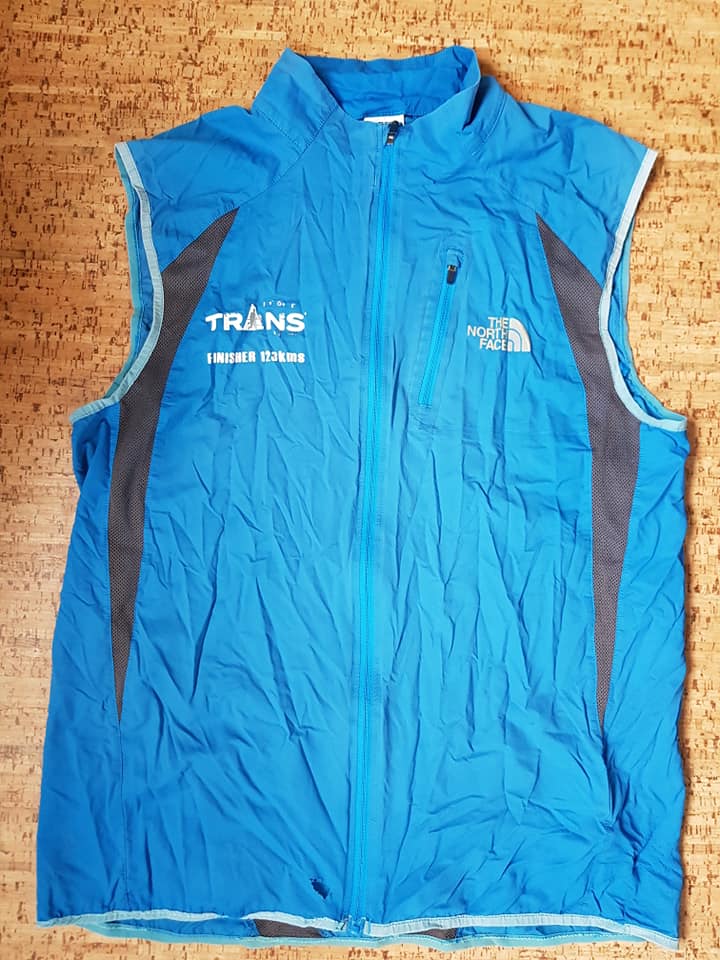
I never owned a gilet till I got this one. I didn’t see the point of them to be honest. But it was a gift for finishing TGC so I took it. It is very thin, so is miniscule and can pretty much be carried without even being aware of it. This is one of the great points about it. But why would I want a windproof without arms or a hood? I buried it in my pack and forgot about it.
Then one day out on a run, I got quite cold and so tried it on. My core warmed up immediately as it kept the cutting wind from chilling me. It also meant that as I continued to work at a high level, the lack of arms meant I wasn’t really overheating. It was exactly what I needed at that point, and since then it has been worn on every single winter run and when I go ski touring. It is perfect! I tried to find a similar gilet from The North Face but couldn’t find one as I got mine about a decade ago now. I now have a new windproof gilet from Cimalp.
Check it out here
Coros Apex Pro
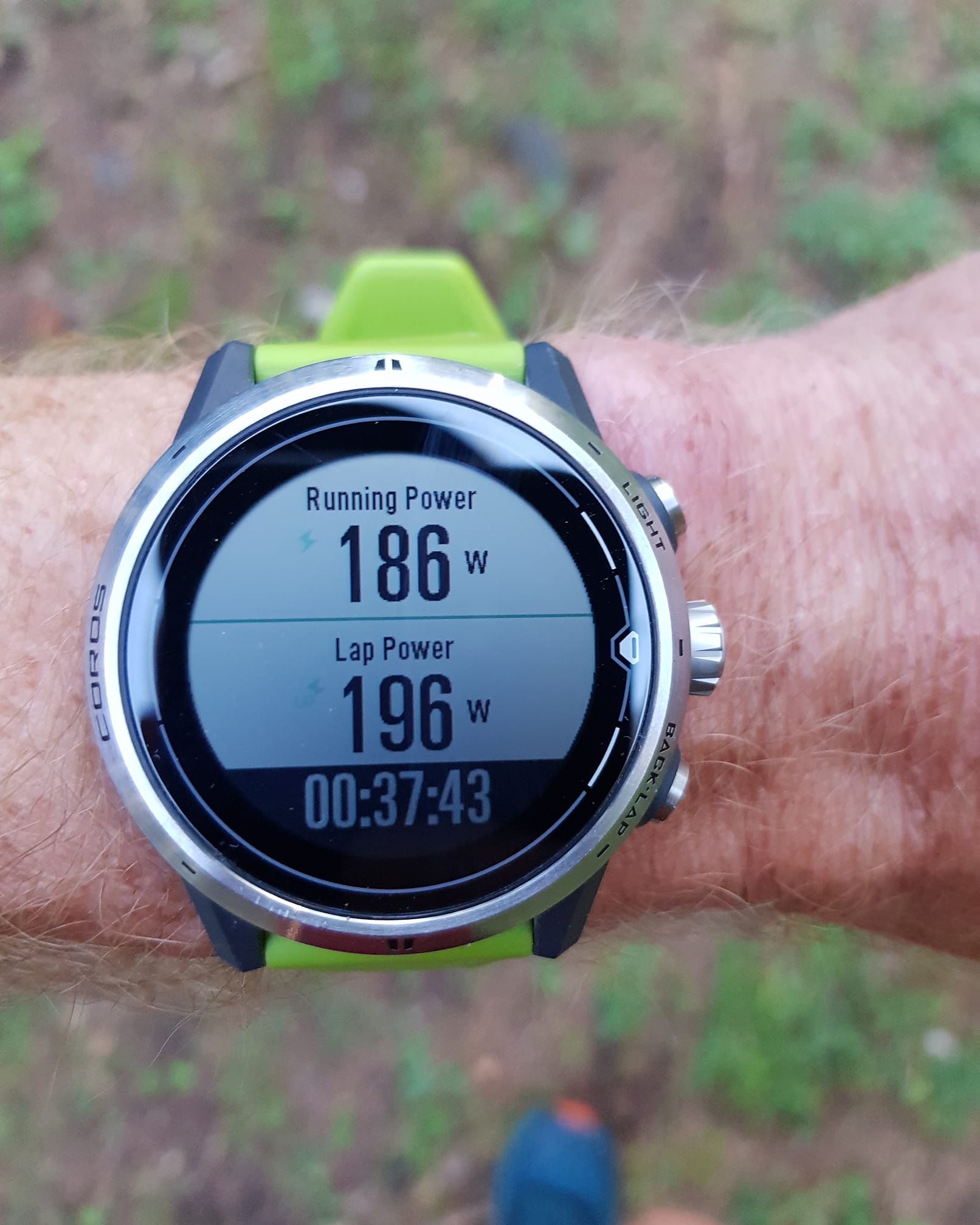
I have had a number of GPS watches over the years, and as much as I hate to admit it, I feel a bit lost if I have to run without one due to lack of charge or something. My Coros Apex Pro only ever comes off to be charged, (and seeing as the Coros watches have such an incredible battery life this is very occasional!) so it needs to look good, be comfortable and needs to work really smoothly. Along with the battery life, the speed that it syncs with the app and also the speed it finds satellites are strong features that help make this a favourite for me.
I wrote a review a while back. Read that here.
Purchase here
Buff or similar
An incredibly simple design that is loved the world over. I don’t think I ever train without one as they are so adaptable. During the winter for warmth and the summer for sun protection and holding ice cubes or soaking in cold water when it’s really hot. I generally have more than one as they are so useful!
Salomon Pulse Belt
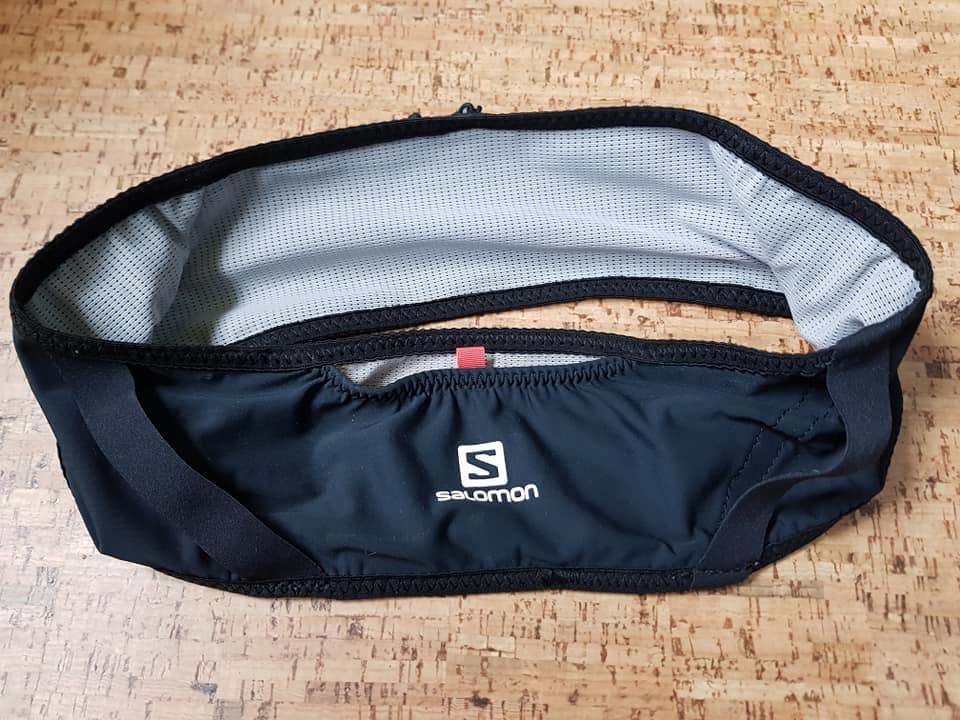
I don’t need to carry a race vest on pretty much all my training runs, but often do need to carry just a few small items plus my phone. For me, the best solution for this is the Pulse Belt by Salomon. A stretchy belt you have to step into, it holds all I generally need for my runs and doesn’t bounce or give me a sweaty back. Perfect!
Purchase here
Kahtoola Micro Spikes
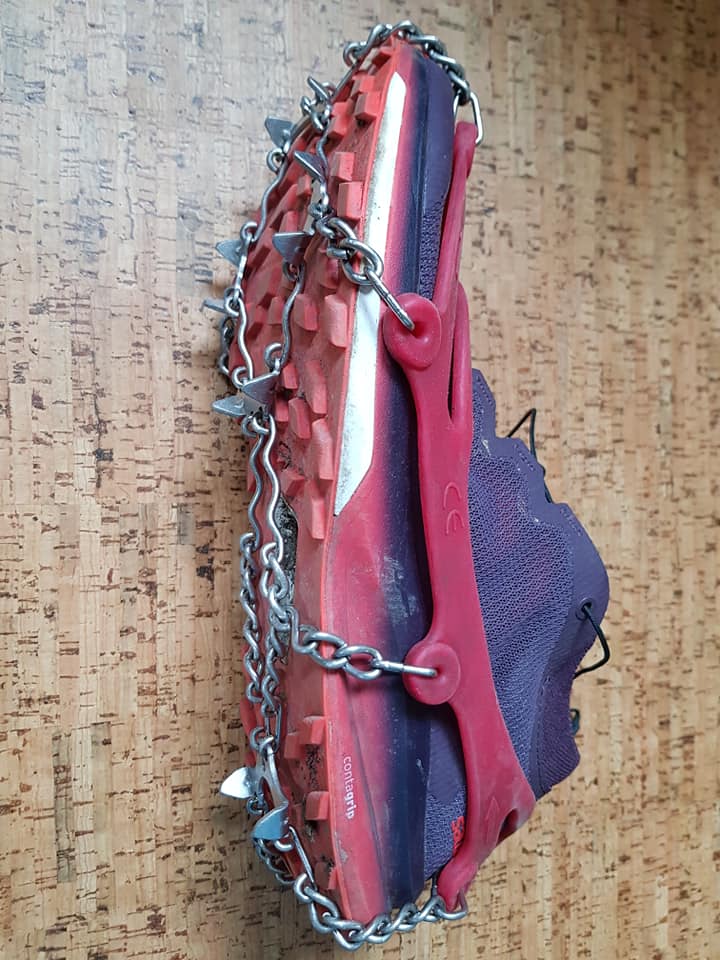
So, this item will get hardly any use from most people, but when it is needed it is an incredibly effective piece of kit! I have had my micro spikes for around a decade and they have been amazing. Bomb proof, Surprisingly grippy on the toughest icy footing. The only issue is that they can get uncomfortable if worn on hard surfaces for long periods, so ideally need to be removed when not needed. Kahtoola do make a slightly mellower set called the EXOSpikes which will still provide plenty of bite, yet be more comfortable as they are a little less aggressive. Read my review of the EXOspikes here
Inov8 Race Ultra Pro 2 in 1 Vest
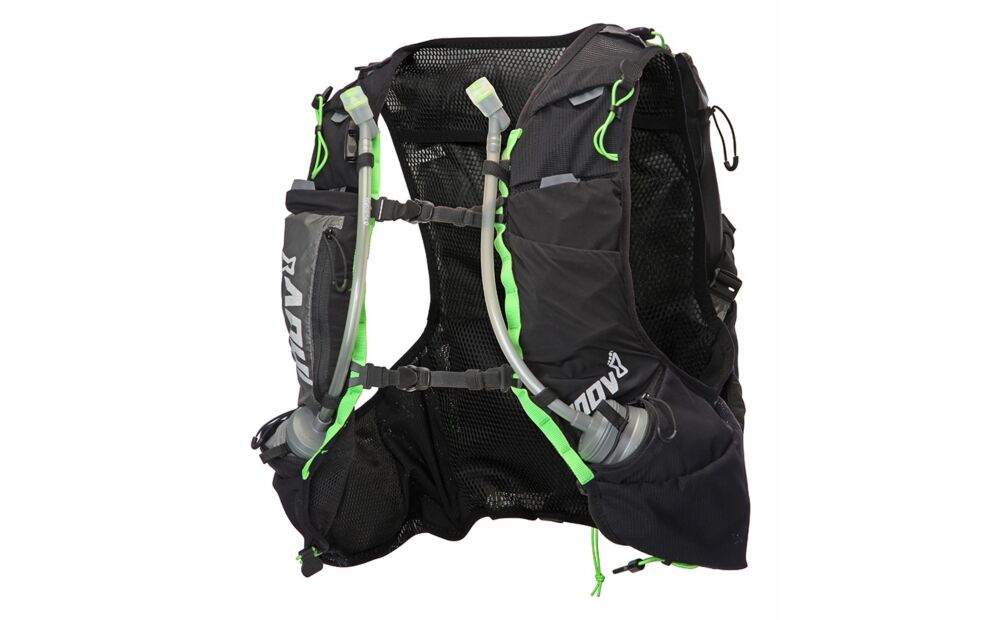
Since Salomon came out with the vest design, I have mostly been wearing theirs as they make excellent packs. That was until I got my hands on this incredibly adaptable and comfortable vest from Inov8.
It has multiple options to carry bottles, carry poles and has an extra pouch that you can attach for those days where you need more gear. The pack that does it all!
I wrote a review a while back. Read it here
Purchase here.
La SportivaKaptiva
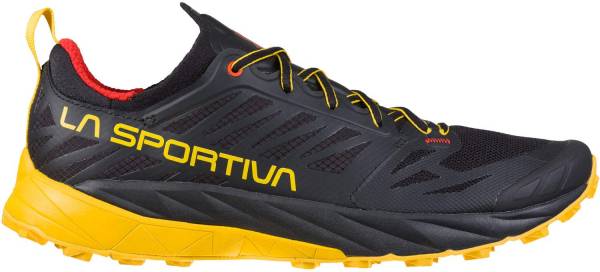
I try many different shoes, and they are more often than not, good these days. Occasionally there are durability issues as the weight drops too far, but can I pick any shoe in particular that has suited me and my running best?
For me the most flawless shoe I have used over the last few years has been the La Sportiva Kaptiva. Remember, this is very personal so people will certainly disagree! It was (Mine died after around 900km) incredibly comfortable, with an agreeable drop, a great grippy tread and excellent durability!
Read my review here
Purchase here
COROS announced as Official GPS Watch Partner to XNRG Events
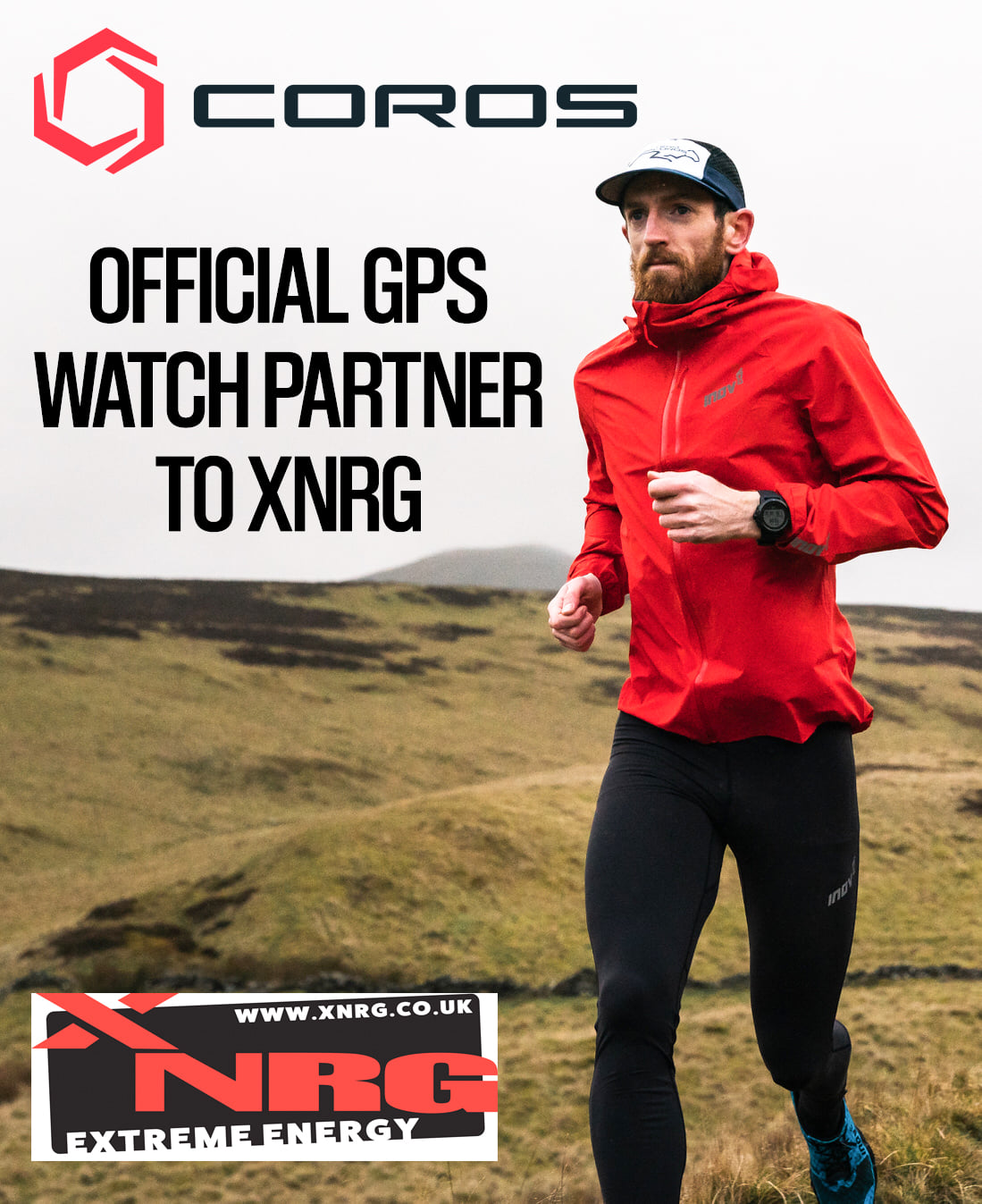
COROS Wearables Inc., makers of performance endurance sports wearables, announced today that they are the Official GPS Watch Partner to the ultra-marathon events organiser, XNRG Events.
As part of the partnership, COROS aims to create a seamless and natural customer journey for first-time athletes thinking of competing in their first ultra-marathon. The partnership will also seek to benefit the more ‘battle-hardened multi-day athlete’, with the potential addition of future events as well the offering of prizes to race winners, event support, and perks for mutual partners.
Northern Europe Market Manager for COROS, Ben Clark said, “Partnering with XNRG will help to increase our foothold in the ultra-running community by ensuring that athletes can continue to attend some of the best events in the industry whilst also wearing a product that has been exclusively designed with them in mind. Our customers value having the best tools for the job, and what better way to test them than by going to compete in some of the best ultra-events the UK has to offer!”
Neil Thubron, owner of XNRG said, “We are excited to announce our working relationship with COROS as we are always looking for quality brands to partner with that will add value to our XNRG community. COROS is the perfect technology for our long-distance single-stage and multiday competitors, boasting great functionality and amazing battery life.”
ABOUT COROS WEARABLES COROS
is a performance sports technology company that helps athletes train to be their best. For COROS it’s all about outdoors, mountains, and a passionate active lifestyle. We combine high-grade hardware with innovative technology to provide endurance athletes with the gear they rely on in the world’s most extreme environments. Advanced technology with an efficient and intuitive user experience is at our core – when you use a COROS product, you know you are getting a tool that has been designed, tested and perfected for the athlete, by the athlete. COROS users have set World Records and been to the highest point on earth, pushing our products to the extremes. At COROS, creation and innovation are never-ending. Our customers, the athletes make COROS – be a part of our community @COROSGlobal + @COROS_UK on Facebook, Instagram and LinkedIn.
ABOUT XNRG
XNRG's mission is to help people challenge themselves and breakthrough their mental and physical barriers, whilst providing peace of mind with expertly run events, going the extra mile for every competitor. Our heartland is multi-day endurance events; we originally started to help people training for the world's toughest desert footrace, the Marathon Des Sables. Today, we welcome hundreds of competitors across our events, from single day ultra-marathons to multi-day events.
Our business is built on 3 values – High-Quality Challenging Events, A Fun Environment, We lead with Safety first.
inov-8 and COROS Wearables have teamed up to help people reap the rewards that exercise brings to mental health.
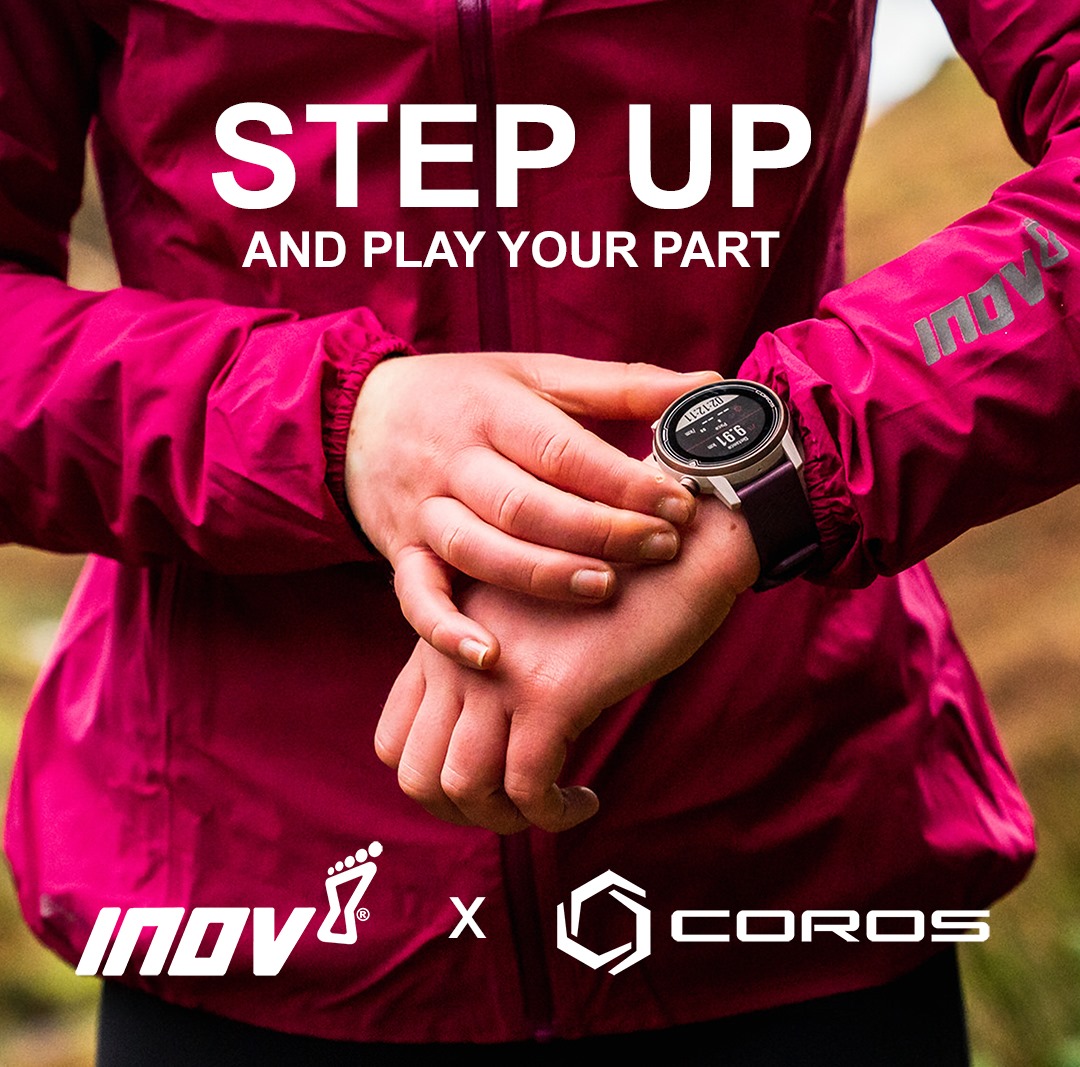
The two sports brands have launched their Step Up & Play Your Part Challenge in a bid to amass 21 million steps of responsible exercise before the end of January 2021.
To do this they are calling on runners, walkers and all sportspeople to log their daily number of steps on the inov-8 website here.
And while both brands are promoting exercise to help people with their mental health during these hugely challenging times of the Covid pandemic, they are also stressing that all exercise must be carried out responsibly and within government guidelines that apply locally.
The challenge is open to everyone worldwide, with inov-8 and COROS offering daily prizes that include award-winning running, hiking & fitness kit and GPS watches.
Michael Price, inov-8 COO, said: “In June last year we digitally brought together a team of more than 1,000 runners globally to complete a 25,000-mile virtual lap of the world within a week.
“The inov-8 World Run was a huge success and proved to be integral in our Play Your Part campaign, set-up at the start of the pandemic to support, motivate and inspire people through these difficult times.
“Now we’re stepping things up a level and looking for people to join us in amassing 21 million steps of responsible exercise, and in doing so improve their mental health at a time when things are incredibly tough for us all.”
Ben Clark, COROS Northern Europe Market Manager, added: “I’m grateful that we were able to partner with inov-8 to bring this fantastic challenge to the world.
"Earlier in the year, COROS also partnered with JoggingBuddy, RedJanuary and our charity partner Sport In Mind to promote exercise as a means to support and motivate both the mental and physical wellbeing of people worldwide.
“Together with our wider partners, we believe that the challenge will be the beginning of a very active and successful year for everyone involved!”
Watches, mobile phones and pedometer can be used to count steps. Get all the details about the Step Up & Play Your Part Challenge and how to log steps here: www.inov-8.com/step-up-play-your-part-2021
Use the hashtags #inov8StepUp and #CorosStepUp on social media to show how you are contributing to the challenge.

